 Denver,
South Park and Pacific Railroad
Denver,
South Park and Pacific Railroad
Large Scale Models of South Park Rolling
Stock and How to Improve Them
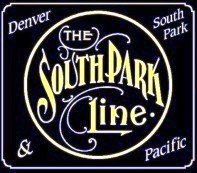 Commercially available large scale models of the DSP&P are not
easy to find. None are currently in production (2022), so the
after-market is the only source. Commercial models are
only moderately correct for the DSP&P in the 1880's - you
can improve this with some small fixes and a couple of larger
mods.
Commercially available large scale models of the DSP&P are not
easy to find. None are currently in production (2022), so the
after-market is the only source. Commercial models are
only moderately correct for the DSP&P in the 1880's - you
can improve this with some small fixes and a couple of larger
mods.
This page shows most of the better models that appeared
commercially over the years, with comments on their accuracy in representing
the real South Park in the 1880s. The following sections cover
models of DSP&P locomotives, freight cars, passenger cars,
examples of detailing and kit-bashing, and some other odds and
ends. If you like detailing your models, scroll on down to see
the commercial products "as delivered" and how small fixes make
them look better. Take a peak at how neat the simulated
wood roof looks! See how I fixed the "Wood Roof
Problem" on freight cars, and the "Silver Roof Problem" on
passenger cars.
Portions of the Locomotives
section were published in "The Bogies and the Loop", the
quarterly magazine of the Denver, South Park and Pacific
Historical Society.
•
July 2020
•
October
2020
•
April 2021
•
July 2020
•
October
2020
•
January
2022
 Large Scale Models of DSP&P 2-6-6T Mason Bogies
Large Scale Models of DSP&P 2-6-6T Mason Bogies
Large
scale modeling of the DSP&P is not easy and ready-to-run,
properly proportioned and decorated locomotives are rare in any
scale. Fortunately, the
Mason Bogie locomotives
that have been available over the years are really quite
faithful models. The Delton and Accucraft models are remarkable
representations; the LGB version somewhat less so.
This section covers the
1:20, 1:22, and 1:24 scale locomotives that ran on my outdoor
railway, with some comments on their peculiarities. A photo
essay
side-trip to some exquisite scratch built Bogies is also covered
here. Super-large scale 1:11 custom built models were added
recently, with links to the original article.
To be thorough, I
have included a failed attempt by Midbar Locomotive Works to
market a plastic version of a DSP&P Mason Bogie.
Below are the
Mason Locomotive Works builder's photo, the Railway Age
engraving, and Evelyn Curro's wonderful art print of the
well known DSP&P 2-6-6T Mason Bogie #15 "Breckenridge".
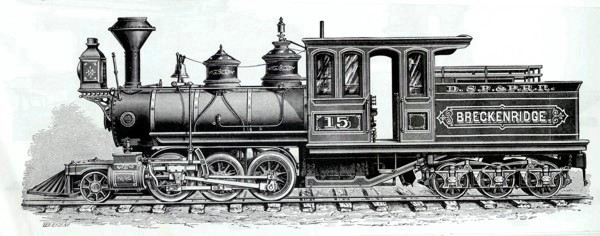
Engraving of DSP&P
2-6-6T Mason Bogie #15 "Breckenridge", originally
published in "Railway Gazette" in 1879, reprinted in "Recent
Locomotives" by Mathias Forney in 1886, and again in "Early American
Locomotives" by John White Jr in 1972. Drawn from the builder's photo
shown below.
Click on
image to capture larger image (0.75
Mb)
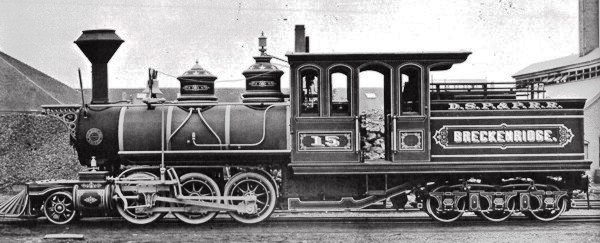
Builder's Photo,
taken in 1879, of DSP&P
2-6-6T Mason Bogie #15 "Breckenridge". The lettering was probably
gold with red drop-shadow. The boiler was Russia iron, probably
light grey or blue, cab and tender box probably dark green or brown,
brightwork polished brass. Photos could not be reproduced in
magazines or newspapers until after 1890 when the duotone process
was invented, so engravers were assigned to redraw photos, as shown above.
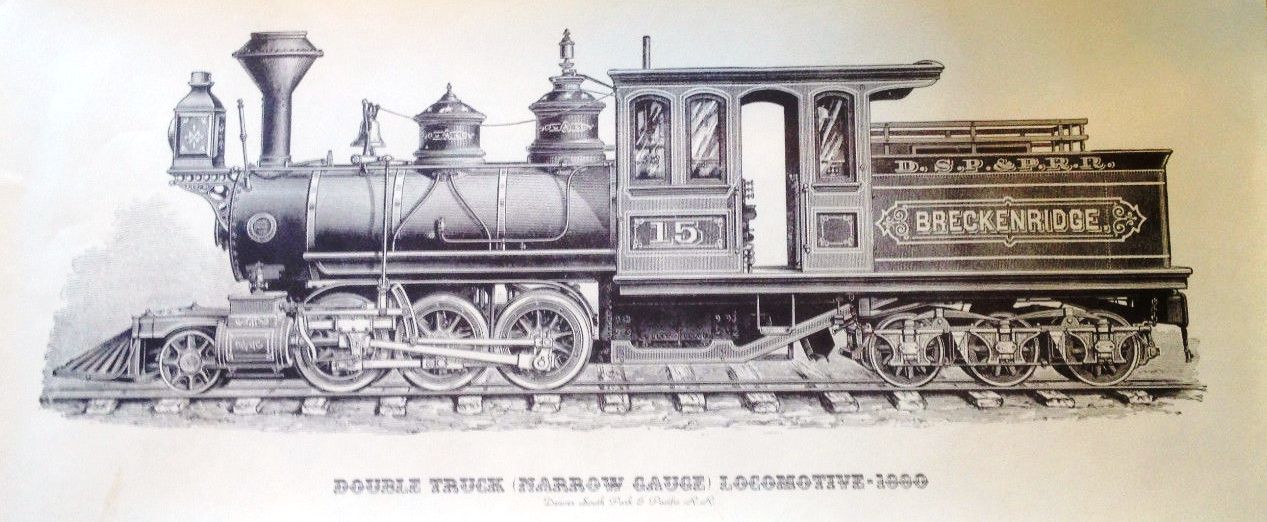
Reproductions of the Breckenridge engraving have been published to
decorate office and home. This print shows some nice detail and can
be found on eBay in a 20 inch wide format.
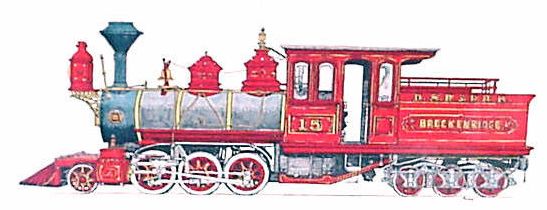
A series of art prints in "The American Rye of Evelyn Curro"
appeared in 1972 and
included this rendering of DSP&P #15 in red
with Russia Iron boiler. Its bright red colour scheme was probably not
authentic, but made for dramatic art. This image may have been the inspiration for the
1983 Delton colour scheme on their 1:24 scale brass model, shown below,
although sadly they didn't keep the iron colour on the boiler.
 The Delton 1:24 Scale DSP&P Mason
Bogie
The Delton 1:24 Scale DSP&P Mason
Bogie
Delton
Locomotive Works (DLW) of Delton, Michigan produced the first
large scale brass models of DSP&P
2-6-6T Mason Bogies, in 1:24 “H” scale, in 1983-84. The models were patterned after DSP&P #15 “Breckenridge”,
the best known of the 14 “light” double truck locomotives that
Mason Machine Works delivered to the DSP&P in 1879.
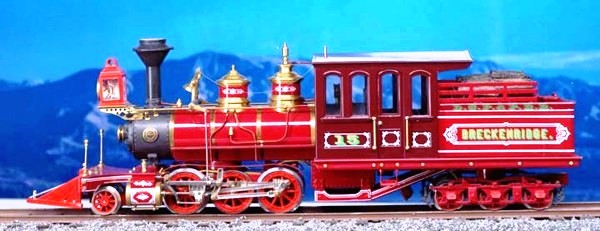
Delton's DSP&P #15
2-6-6T "Breckenridge" in the burgundy and red paint scheme, showing
the many individual decals representing the pin-striped original.
The red drop-shadow on the lettering is there, but doesn't
photograph well..
This was the first group of brass models manufactured by Delton,
in conjunction with RichArt Company of California. It was
offered only as an electric powered 12 volt DC version. As on
the original, the model’s power truck swivels under the boiler.
The center drivers are blind and it has a small diamond
smokestack matching the builder’s photo.
A
total of 189 models were built, 140 in a somewhat garish red and
burgundy, which was claimed to “closely match the paint color of
the original Breckenridge”. I personally doubt this, but that is
the story promoted in the DLW history in the hardcover reference
book by Lenny Sloboda (Sloboda Publishing, Astor, Florida). Of
the remaining 49 models, 10 were delivered in naked brass, the
remainder in 5 different colour schemes, as documented in
Sloboda’s book.
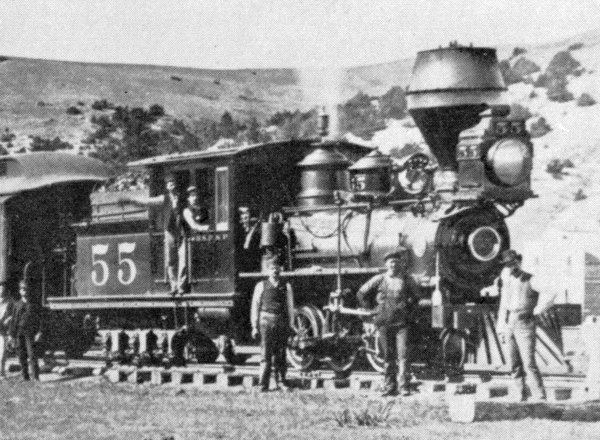
DSP&P 2-6-6T Mason
Bogie #55 (originally #22 "Crested Butte"). Delton produced one
brass model painted to match this photo.
The level of detail is excellent, but not quite as fine as the
2007 Accucraft version, partly because the DLW model is 1:24
instead of 1:20 scale. The finish is also excellent, with many
tiny decals applied to represent the various flourishes and
stripes. Domes and headlight are well done. There is no coal in
the coal bunker. The side cab doors are spring loaded but the
front cab doors are solid. Windows are not moveable.
Drivers and rear bogie are painted red and look quite nice this
way. Accucraft’s versions have these items painted black. Photos
have appeared online of burgundy-coloured models with the boiler
repainted in russia Iron, giving a much more attractive image
than the bright red boiler of the original DLW model.
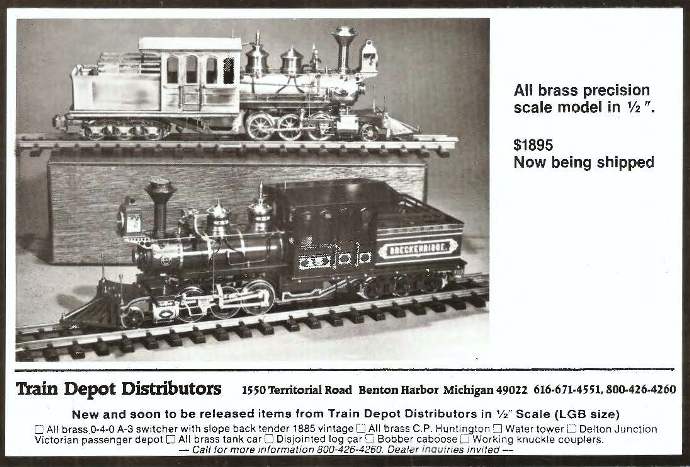
An early advert for the
Delton Mason Bogie, Garden Railways Magazine, Sep 1984
The original DLW locomotive was not “sound-ready” as this
concept had not been developed at the time. It is relatively
easy to add basic LGB-style sound sensors and an American steam
sound module in the coal bunker. Full DCC sound might be more
difficult due to lack of space.
VITAL STATISTICS: Delton DSP&P Mason Bogie #15 “Breckenridge”,
1:24 “H” Scale
Retail price: then $2000, now $1500 to $6000 range, depending on
scarcity of colour scheme, and condition Model numbers: D2100
(naked brass), 2101 (red/burgundy), 2102 – 2106 (rare colours)
Weight: 9 pounds Size: 19.5” long by
4.2” wide by 6.5” high Minimum radius: 2 feet
Power: 0 to 12 volt DC motor
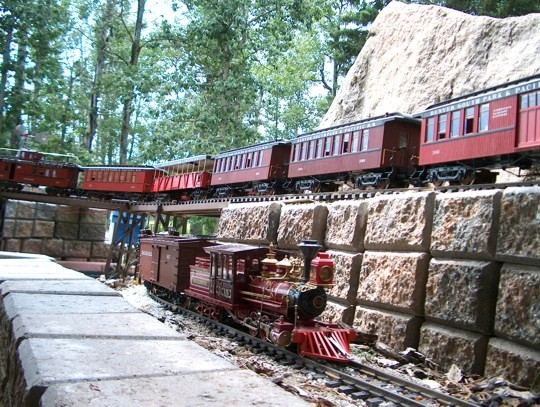
Head shot of Delton's DSP&P #15 "Breckenridge" about to enter
Glacier Tunnel on the author's outdoor railway, with the Express on
the Highline above.
 The
Accucraft 1:20.3 Scale DSP&P Mason Bogies
The
Accucraft 1:20.3 Scale DSP&P Mason Bogies
Advertised in 2007, the first prototype of Accucraft’s 2-6-6T
Mason Bogie, in 1:20.3 “F” scale, made an appearance online in
the summer of 2009, with deliveries to customers occurring in
late 2010. The models were patterned after builder’s photos and
plans of the early “light” DSP&P Mason-built locomotives. This
double truck design won the 1888 World's Fair prize for “Best
Piece of Machinery” built in that decade.
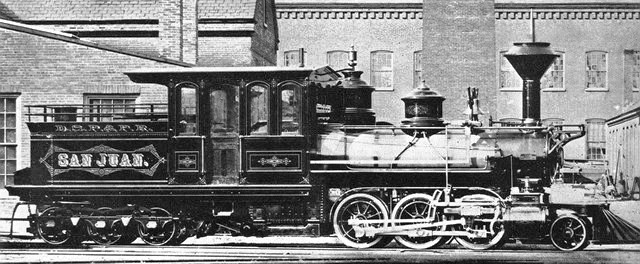
Builder's Photo DSP&P #4 "San Juan", a 2-6-6T Mason Bogie, later
renumbered DSP&P #41, Note the tender flare carries D.S.P. & P.
R., not "R.R." as on later engines.
The
models come in two liveries: a dark green version of DSP&P #4
“San Juan” and a chocolate brown DSP&P #6 “Tenmile”. Both have
simulated Russia Iron boilers and simulated ash or oak cabs with
the exquisite arched windows. Both were available as electric or
live-steam versions. David Fletcher’s initial artwork for these
models is shown
HERE
and his plans for both engines were published in “The Bogies and
the Loop” in July and September 2004. The full set of David's
Mason Bogie Master-Class plans are
HERE.
The body
of the Accucraft model is built from heavy brass with steel
drivers, side rods, and linkage. The engine swivels under the
boiler and the center drivers are blind, just as on the full
scale Mason Bogies that were delivered to the DSP&P in 1879. The
level of detail is excellent, especially the Nesmith smokestack,
domes, headlight, pilot, and rivet patterns. Paint and
lettering, especially the stripes and decorative flourishes, are
superb. All four doors are spring loaded and one window on each
side slides open.
 The final
“R” of D.S.P.& P.R.R. is missing on the coal bunker flare on the
“San Juan”, as on the Mason Machine Works builder’s photo. The
second “R” is present on the “Tenmile” model,
The final
“R” of D.S.P.& P.R.R. is missing on the coal bunker flare on the
“San Juan”, as on the Mason Machine Works builder’s photo. The
second “R” is present on the “Tenmile” model,
The
electric versions are sound-ready but not plug-and-play – there
is a rat’s nest of open ended wires in the coal bunker and a
brief reference to the colour codes in the maintenance manual.
There is no coal in the coal bin, which lifts out to access the
wiring harness. Coupler pockets are designed for link-and-pin
fittings (not supplied).
DSP&P "Tenmile"
and "San Juan", with Waycar
#60, on the author's outdoor railway 
I have no
personal experience with the steam powered units. Online reports
suggest 30 to 40 minute run–times, depending on loading and
weather. There are some good videos of these steamers on
YouTube. The engine has a single flue boiler, two cylinders with
piston valves, sight glass, pressure gauge, safety valve,
lubricator, Walschaerts valve gear, reverse lever, and throttle.

Accucraft's version
of DSP&P #4 "San Juan"
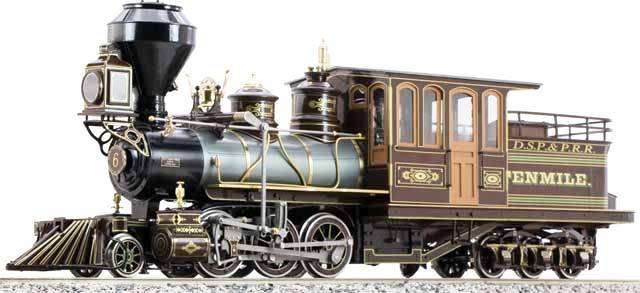
Accucraft model of DSP&P #6 "Tenmile"
 The LGB
1:22.6 Scale Forney, Masquerading as a DSP&P Mason Bogie
The LGB
1:22.6 Scale Forney, Masquerading as a DSP&P Mason Bogie
It
is definitely an ODD addition to my DSP&P fleet as it is a model of
a locomotive that DSP&P never owned. I refer of course to the LGB
21252 1:22.6 “G” scale version of an 0-4-4T Forney painted as DSP&P
#2, named “South Park”. None of this is true to the prototype. DSP&P
#2 was a Dawson and Bailey 4-4-0; none of the South Park’s
locomotives were ever named “South Park”. And it's a Forney, mot a
Mason Bogie. Oh well....
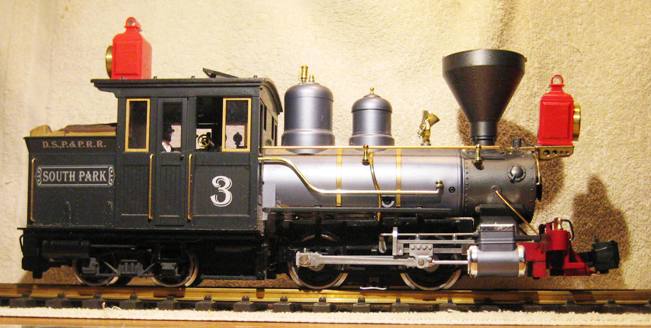
LGB's 0-4-4T "Mason Bogie",
renumbered, as it appeared on the author's railway, I swapped the
"too modern" headlights for more era-specific versions.
If you
don’t count the drivers too carefully, you can imagine that #3
is a South Park Mason Bogie. A new number, name, smoke stack,
and headlight would help the illusion (delusion?), as would a
pilot truck. The factory installed sound system emits the
European whistle that sounds like the death throes of a wounded
mountain goat. The driving truck on this model swivels like a
Mason Bogie, unlile most Forneys which had drivers fixed to the
main locomotive frame.
The price was right and nothing else resembling a
real Mason Bogie was available at the time, so this model passed
for my first Mason, renumbered to represent DSP&P #3 – at least
the number, if nothing else, is correct for a Bogie.
 The
Midbar 1:22+/- Scale DSP&P Mason Bogies
The
Midbar 1:22+/- Scale DSP&P Mason Bogies
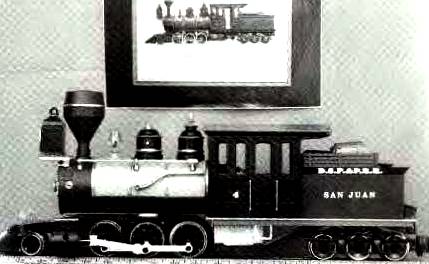 A
model of a 2-6-6T DSP&P Mason Bogie and a Waycar were advertised
in 1992 and 1993, manufactured by Midbar Locomotive Works.
Price, scale, and construction materials were not stated. A photo
caption in the Apr 1993 Outdoor Railroader indicates that the
locomotive was based on an inexpensive plastic superstructure,
probably the Echo toy train set, with a kitbashed Bachmann
caboose (images from OR Dec 1992 and Apr 1993). Based on
this scant description,
the
level of detail could not match that of the Delton and Accucraft
brass models described elsewhere on this page. The ads read
"Patience Please" for the next two years and disappeared by
1996, so this Bogie may have been vaporware.
A
model of a 2-6-6T DSP&P Mason Bogie and a Waycar were advertised
in 1992 and 1993, manufactured by Midbar Locomotive Works.
Price, scale, and construction materials were not stated. A photo
caption in the Apr 1993 Outdoor Railroader indicates that the
locomotive was based on an inexpensive plastic superstructure,
probably the Echo toy train set, with a kitbashed Bachmann
caboose (images from OR Dec 1992 and Apr 1993). Based on
this scant description,
the
level of detail could not match that of the Delton and Accucraft
brass models described elsewhere on this page. The ads read
"Patience Please" for the next two years and disappeared by
1996, so this Bogie may have been vaporware.

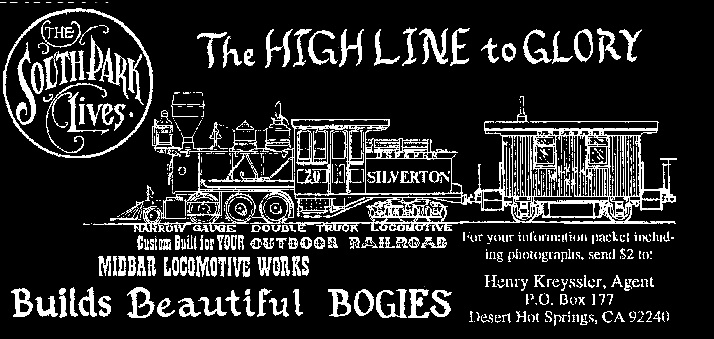
 Some Handcrafted 1:20.3 Scale DSP&P
Mason Bogies
Some Handcrafted 1:20.3 Scale DSP&P
Mason Bogies
David
Fletcher put a great deal of time and effort into his online Master
Class series on building large scale models of Mason Bogies.
Here are a couple of samples from participants. See all of David's
construction articles and drawings
HERE.
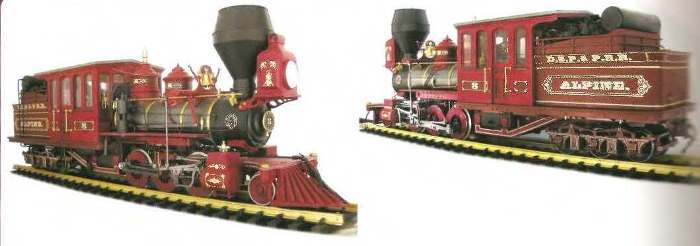
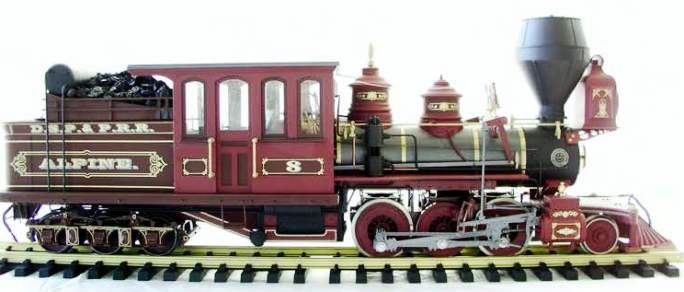
DSP&P 2-8-6T Mason Bogie #25 "Alpine", photos from David Fletcher's Master
Class webpages

DSP&P 2-6-6T Mason Bogie #12 "Como", photo from David Fletcher's Master
Class webpages
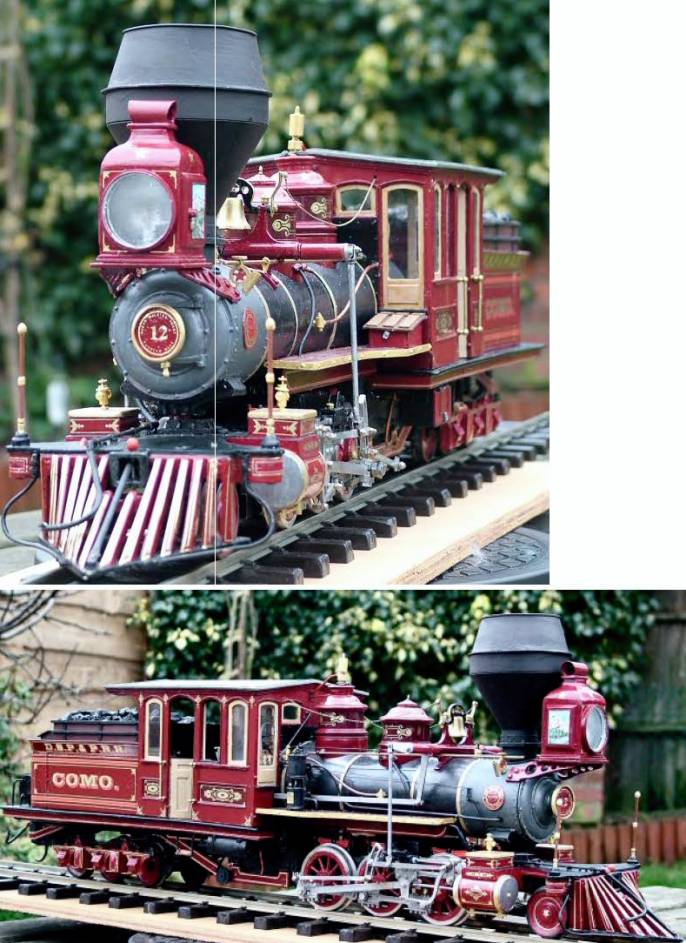

Three more shots of the scratch built DSP&P 2-6-6T Mason Bogie #12
"Como"
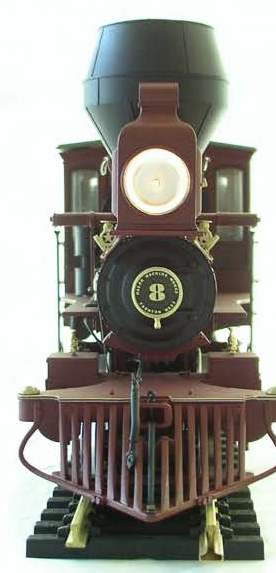
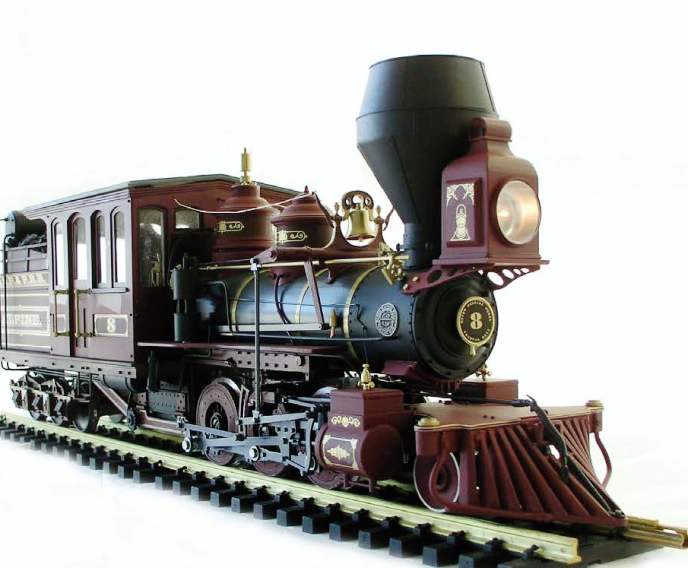
Two shots of the scratch built DSP&P 2-6-6T Mason Bogie #8 "Lake
City"
 Handcrafted 1:11.25 Scale DSP&P
Mason Bogies
Handcrafted 1:11.25 Scale DSP&P
Mason Bogies
David Fletcher's plans
inspired
Martin Rindlisbacher of Switzerland
to build three DSP&P Mason Bogies in 1:11.25 scale running on 80 mm
gauge track (known in Europe as Spur 80), representing 36 inch
narrow gauge. The models are made entirely of wood with some brass
detail parts, fully functional with remote control. One of Martin's
photos is shown here. See the whole story at
http://fluhdesign.ch/?p=2042.
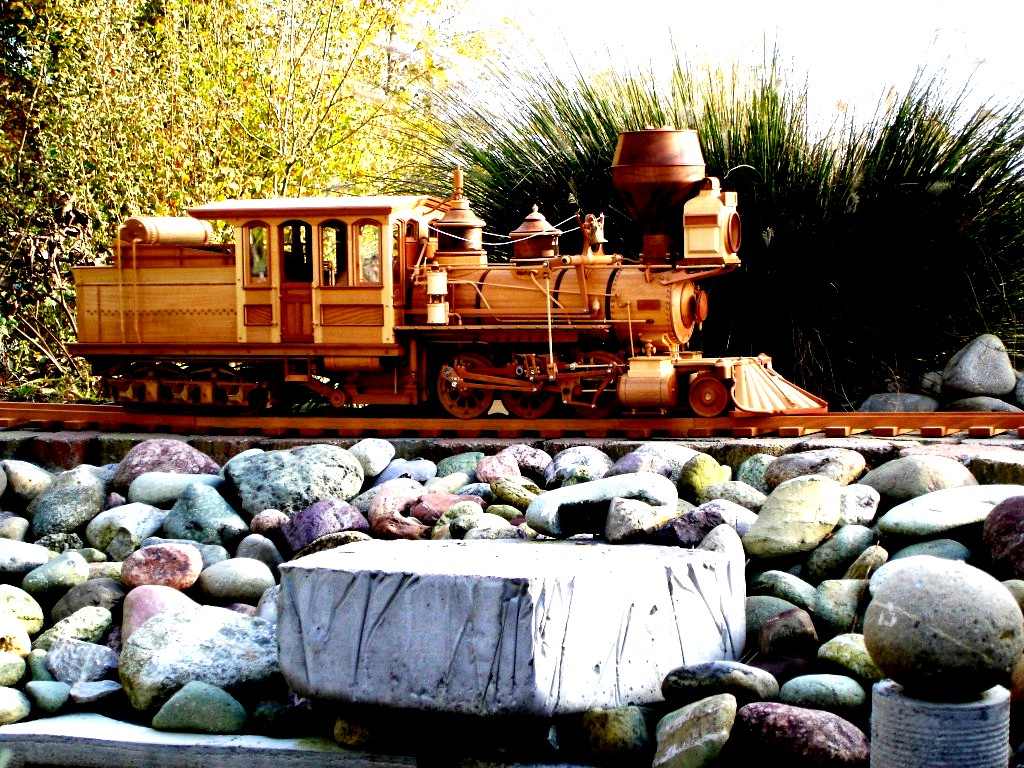
 South Park
MASON BOGIE DETAILS
South Park
MASON BOGIE DETAILS
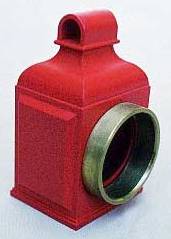 This
section is a collection of photos showing details of large
scale models of early versions of Mason 2-6-6T locomotives.
These were gathered from the internet in 2009 and went missing
in my disorganized archives until 2019. As a result I no longer
remember the source, builder, or scale of these fine models. You
may find a detail of interest for use in your derailing project.
This
section is a collection of photos showing details of large
scale models of early versions of Mason 2-6-6T locomotives.
These were gathered from the internet in 2009 and went missing
in my disorganized archives until 2019. As a result I no longer
remember the source, builder, or scale of these fine models. You
may find a detail of interest for use in your derailing project.
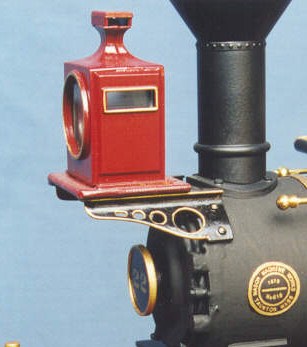

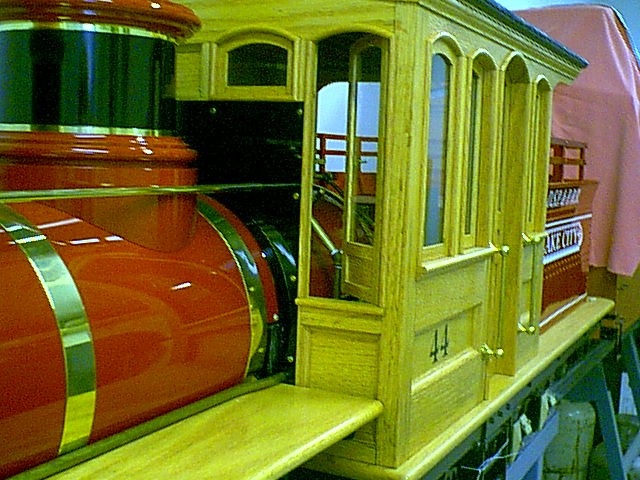

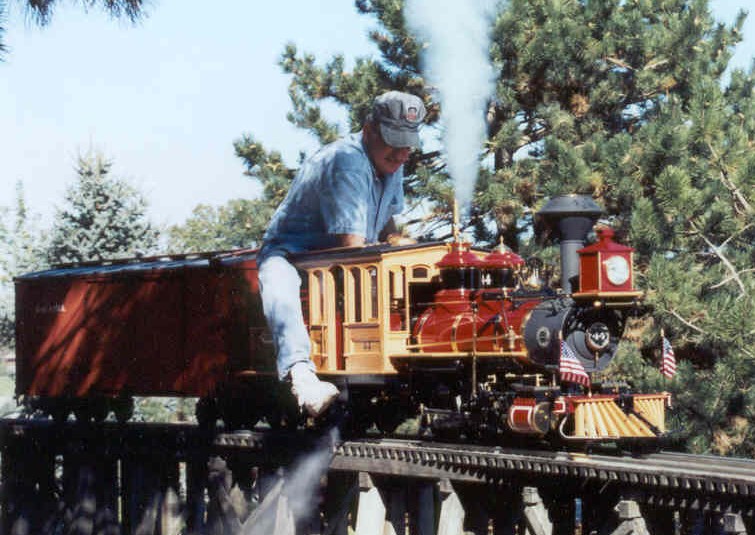
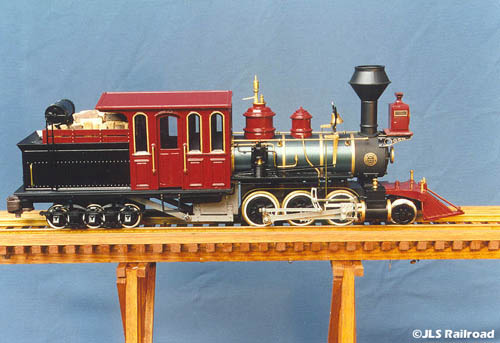
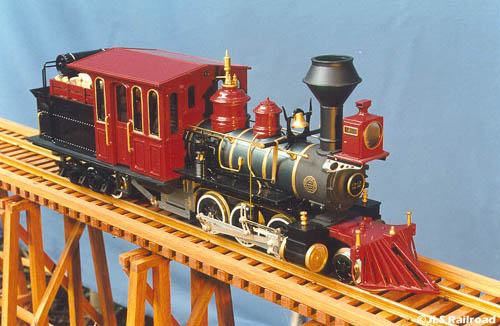
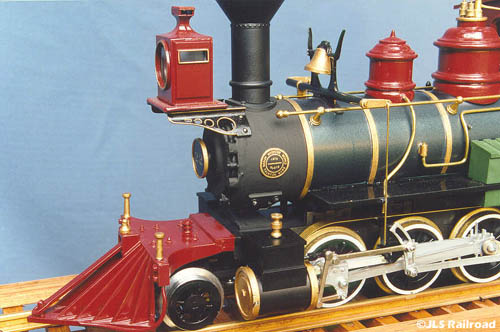
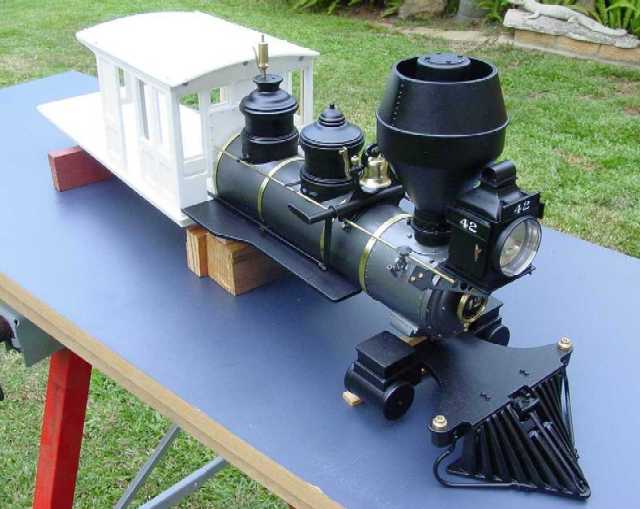
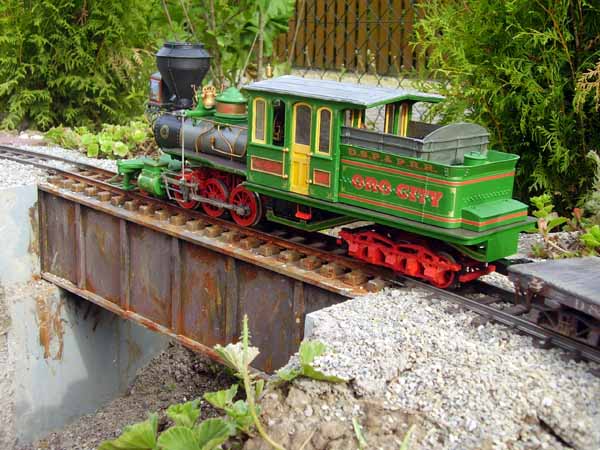
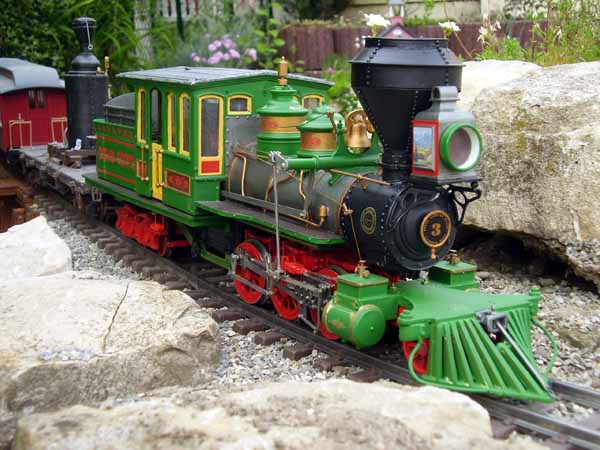
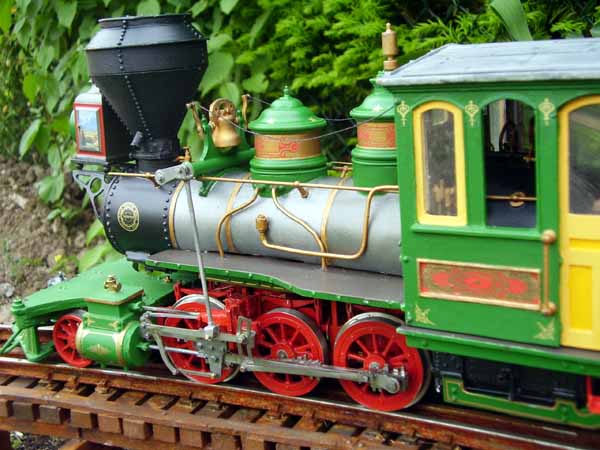
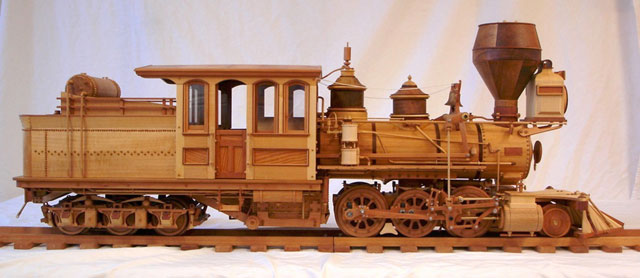

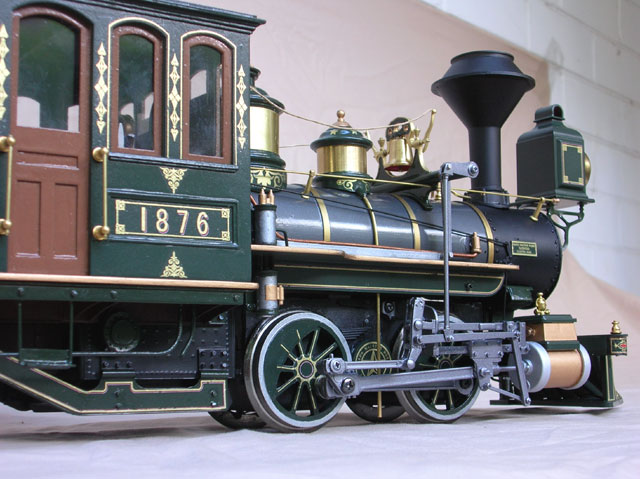
 LARGE
SCALE MODELS OF South Park 2-6-0 MOGULS
LARGE
SCALE MODELS OF South Park 2-6-0 MOGULS
The
large scale Mogul locomotives that
have been available over the years can "pass" if you don't look
too closely for some specific "South Park" details.
This section covers the
1:22 scale LGB Mogul locomotives that ran on my outdoor
railway, with some comments on their peculiarities. A brief
comment on the Echo "toy train" version of a large scale DSP&P
2-6-0 is appended at the end of the section.
DSP&P
owned three series of 2-6-0 Mogul locomotives. The first were
built in 1875 by Dawson and Bailey, numbers 17, 18, and
19. The second set were numbered 29 through 38, built in 1882 by
Brooks. The final group were built by Cooke in 1884, numbered 39,
40, and 69 through 74.
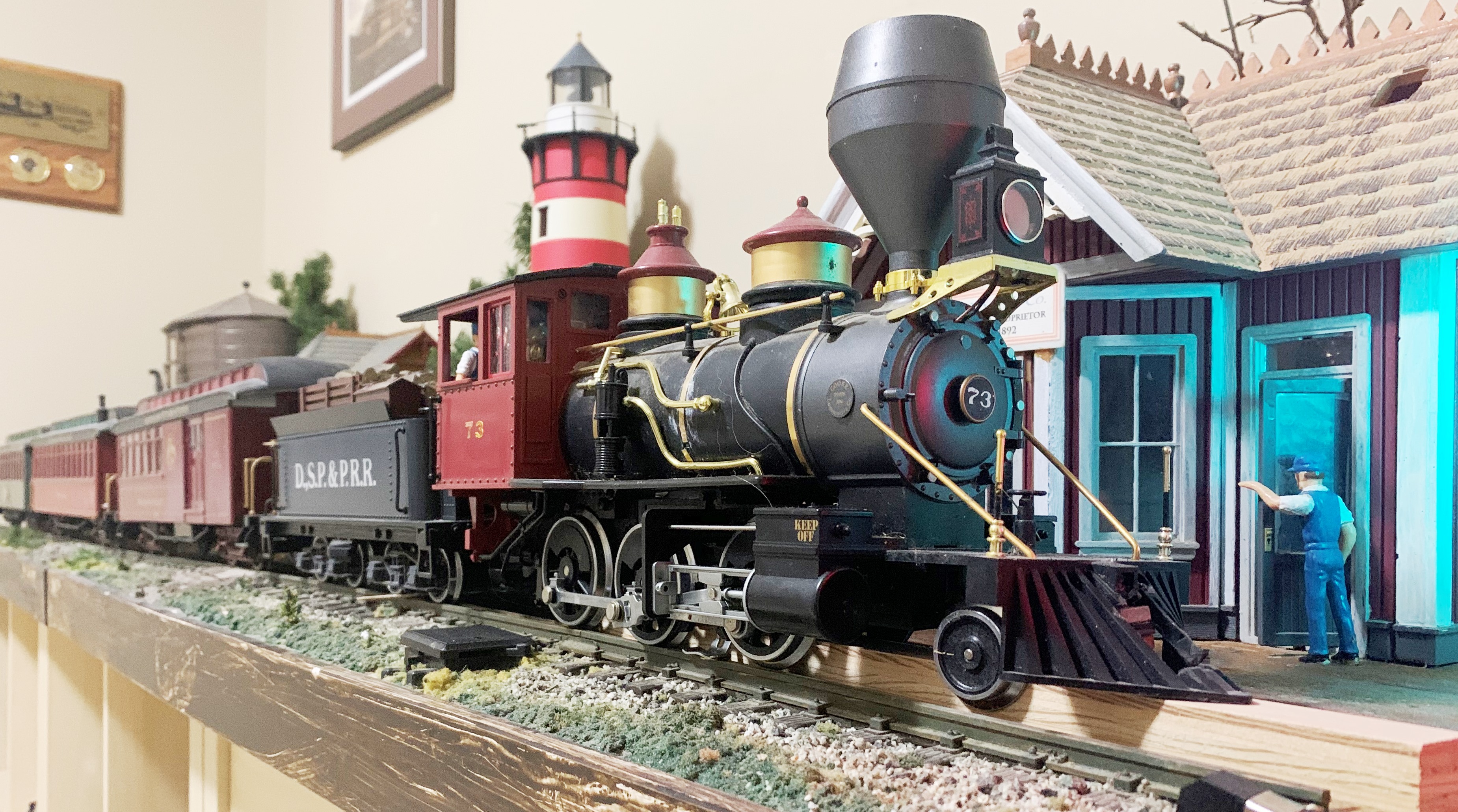
 IMAGES
OF FULL SIZE DSP&P 2-6-0 Moguls
IMAGES
OF FULL SIZE DSP&P 2-6-0 Moguls
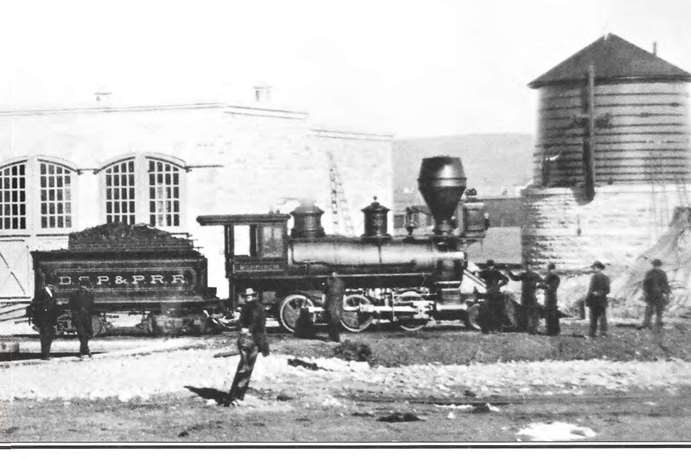
DSP&P Brooks Mogul
#35 "Dillon"
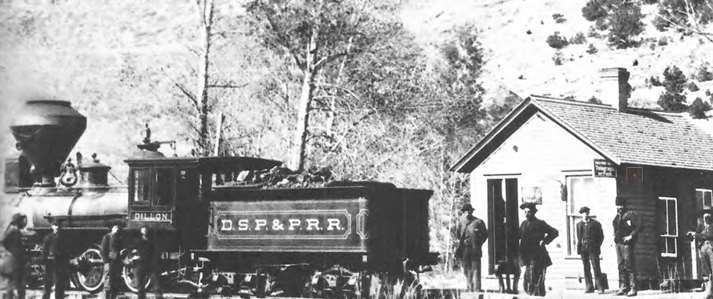
The left side of "Dillon"
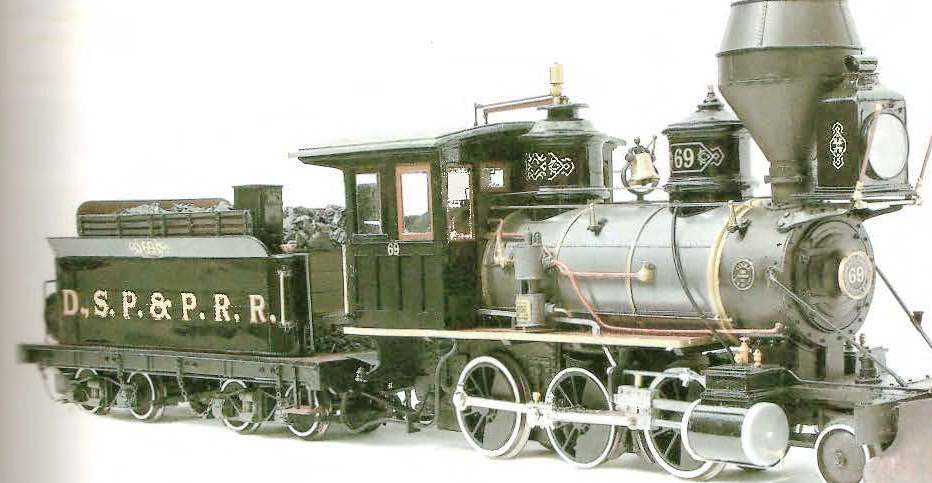
Photo of DSP&P Cooke Mogul #69 - note
fancy scroll work on the domes
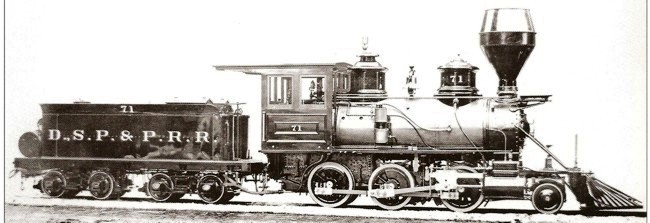
Builder's Photo DSP&P Cooke Mogul #71

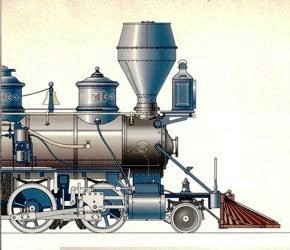

CAD drawings of DSP&P
2-6-0 Mogul #71 from "Model Railroader" Dec 1998. This
plan shows two air tanks on the rear deck of the tender - one large,
one smaller.

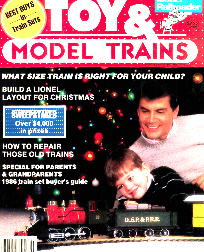 The
LGB 1:22.6 Scale
DSP&P Moguls
The
LGB 1:22.6 Scale
DSP&P Moguls
LGB
produced its first 1:22.6 “G” scale model of a 2-6-0 Mogul in
1985. It was inspired by DSP&P steam locomotives of 100 years
earlier and was a reasonable replica of the Cooke Locomotive
Works 2-6-0’s delivered to DSP&P in 1884. Unfortunately, the
model arrived molded in garish red and green plastic and
lettered as DSP&P #18 (LGB2018D). DSP&P #18 was a Mogul but one
built by Dawson and Bailey, not Cooke, The model had ornate
domes, brass handrails, the famous Nesmith smoke stack (with no
rivet detail), and a wood load in the tender, even though these
locomotives never burned wood. The big air tank on the rear deck
of the tender was also missing, although a small tank was
present. Oh well, it was the first
affordable large scale locomotive with a US profile, and we all
had to make do with what we could find.
The cover of the
1986 "Toys and Model Trains" magazine (precursor
to "Classic Toy Trains") showed the first LGB 2-6-0 Mogul 
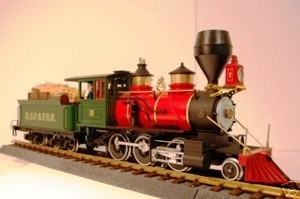
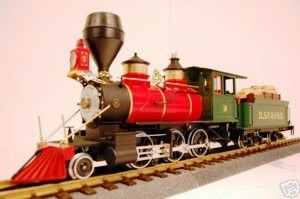

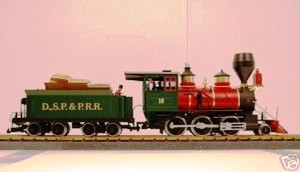
LGB's 2-6-0 Mogul
dressed as DSP&P #18 with non-prototypical colours. DSP&P 17 - 19
were Dawson & Bailey-built in 1875. These early D&B Moguls may have
used wood or coal, so the wood load in the tender is plausible. The
2006 LGB version, DSP&P #20, looks identical but had
built-in sound and DCC.
After this,
LGB produced many versions of Moguls, labeled for different US
railroads, sometimes with non-prototypical colours and
numbering. Over the years, 6 of the 7 modernized C&S Cooke
Moguls have been represented as they appeared in the early
1900’s (C&S #6 through 10), with simulated steel cabs, smooth
domes, straight stacks, some with bear trap spark arrestors or
snowplows, and coal loads in the tenders. An ornate old-time
version was produced for C&S #5, and it is very attractive.
The Oct 1986 "Narrow Gauge and Shortline Gazette" carried an
article by Glenn Joesten showed a repaint and detailing of the
original DSP&P #18 into DSP&P #71, with appropriate colours on
the cab, boiler, and tender. In 1988, LGB discontinued #18,
replacing it with #71 (LGB2028D) with a paint job similar to
Glenn’s. They didn’t add the missing air tank on the rear tender
deck though.
The level of detail on all LGB Moguls is moderate
compared to the brass models discussed elsewhere on this website. The model bears a strong
resemblance to the builder’s photo of #71, but I can’t vouch for
accuracy of the dimensions. The finish is good but a little
weathering will help subdue the plastic look. This engine is a
good prospect for a super-detailing project.
The original LGB Mogul locomotive was not “sound-ready”. It is
relatively easy to add basic LGB-style sound sensors or full DCC
and an American steam sound module in the tender. Some more
recent Moguls come with factory sound, including the C&S #5 and
DSP&P #20. At the moment, only aftermarket models of DSP&P
versions of the LGB 2-6-0 Moguls are available, as there are
none in the current LGB catalogue.
VITAL STATISTICS: LGB DSP&P 2-6-0 Moguls #18 and #71, 1:22.6 “G”
Scale
Retail price: then $350, now $450 to $950
Number built as DSP&P: ? (10000 in 1988)
Model numbers: LGB 2018D (#18), LGB 2028D (#71) plus 7 C&S
versions
Weight: 8 pounds
Size: 26.5” long by 4.2” wide by 7.5” high
Minimum radius: 2 feet Power: 0 to 16 volt DC
motor
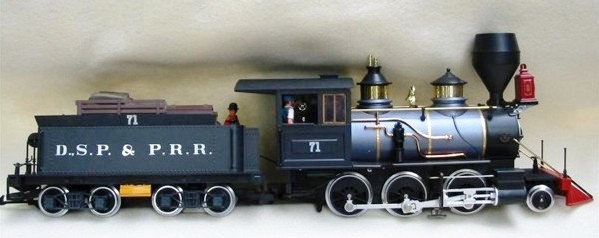
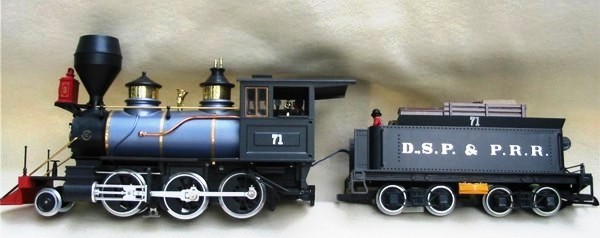
LGB's 2-6-0 Mogul
dressed as DSP&P #71, with reasonably correct colours. DSP&P 69 - 74
were Cooke-built in 1884. DSP&P Cooke Moguls always used coal so the
wood load in #71 is incorrect. Numerous details could be added based
on the builder's photo and recorded DSP&P practice.
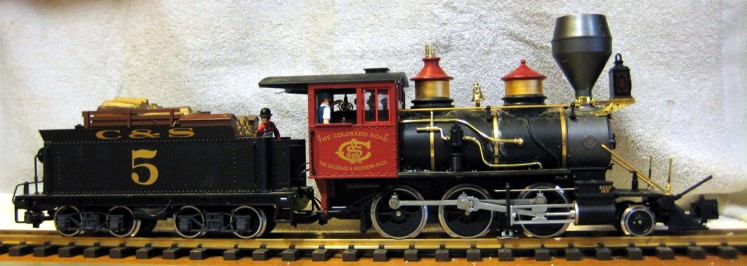
LGB also turned out a Congdon-stacked C&S Mogul #5 (DSP&P #40/110)
with a nice paint job and logo on the cab sides, representing a
possible "turn of the century" version. The cab is a
simulated riveted steel design compared to the simulated painted
wood on the DSP&P models. It had a nice built-in sound
system. Several other more modern C&S Moguls were produced with the
classic black and silver paint schemes, one with a snow plow pilot,
others with bear-trap spark arrester, and some plain-jane
straight-stack versions.



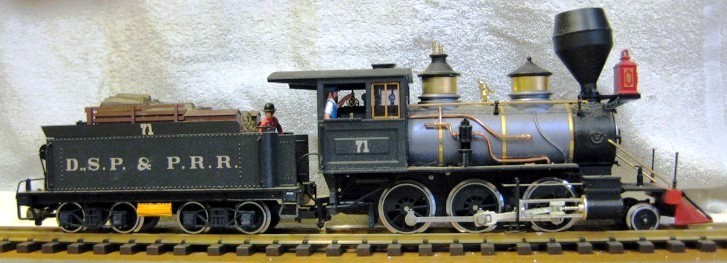
DSP&P 17, 18, 19,
and 71 as they appeared on the author's outdoor railway. #18 and 71
are pretty much as delivered by LGB. #19 is the D&RG version with a
DSP&P tender. #17 has a #71 boiler and a #18 cab, renumbered.
 The
ECHO 1:22+/- SEMI-Scale DSP&P Mogul
The
ECHO 1:22+/- SEMI-Scale DSP&P Mogul
This model was produced in the
early 1990's and was intended as a toy. it could run on LGB or other
brands of #1 gauge track or on the plastic track supplied with the
set.
It ran on 4 C-cells in the tender and could just barely pull the
tender and two cars included. The slightest grade would stall it. I
owned one briefly to see what could be done with it, but gave it
away as a kid's push toy. These sets show up periodically on eBay.
Don't be fooled by the vendor's description - it really is just a
toy.

Image of Echo's DSP&P toy train set from the packaging lid. The
freight cars never matched the locomotive road name. The set
included plastic track and a trestle, although the train could not
climb the slightest grade.
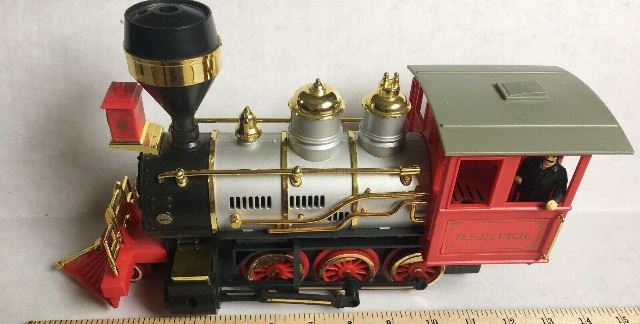
Left side of Echo 2-6-0 Mogul. Drivers and connecting rods are
plastic, as are all other parts. Note motor cooling slots in lower
part of the boiler shell.
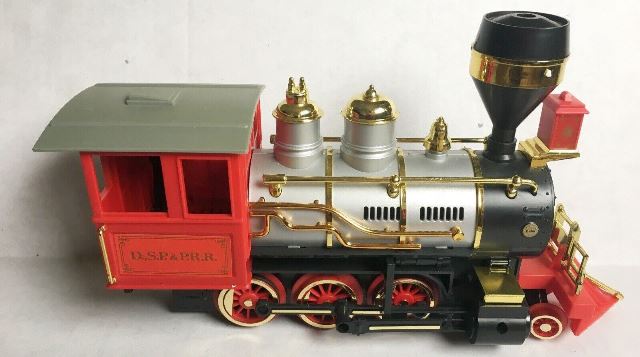
Right side of Echo 2-6-0 Mogul.
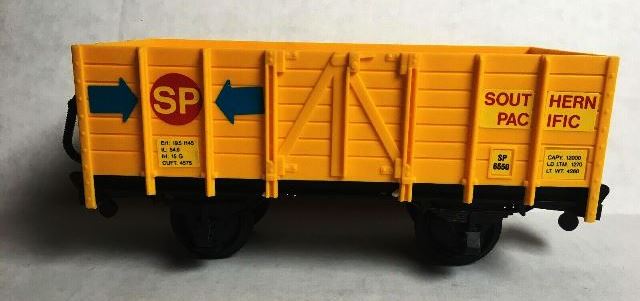
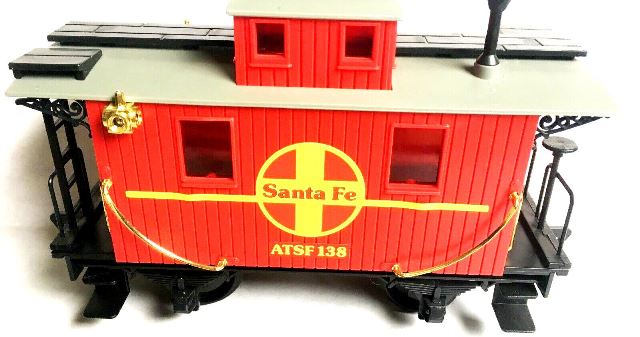
The included rolling stock was a 4-wheel gondola labeled South
Pacific and a 4-wheel bobber caboose with cupola, labeled for ATSF.
These may have varied from time to time.
 Large Scale Models of DSP&P
2-8-0
Consolidations
Large Scale Models of DSP&P
2-8-0
Consolidations
Large
scale modeling of the DSP&P 2-8-0 by Aristocraft's Delton
Classics line are decent 1:24 scale representations. The
newer Accucraft 2-8-0
Consolidations, based on David Fletcher's detailed plans, are remarkable
models, with very faithful
details and colour schemes.
This section covers the
1:20 scale Accucraft and 1:24 scale Delton / Aristocraft locomotives that ran on my outdoor
railway, with some comments on their peculiarities.
DSP&P 2-8-0 Consolidations #41
through 49 were built by Cooke and were delivered in 1883. Numbers 50
through 57 were Baldwin products, and #58 through 68 were again Cooke
models, also delivered in 1883.
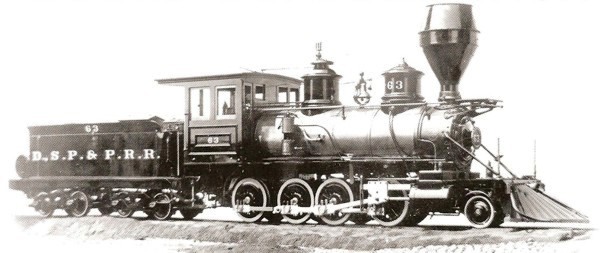
Builder's Photo Cooke
Consolidation DSP&P #63
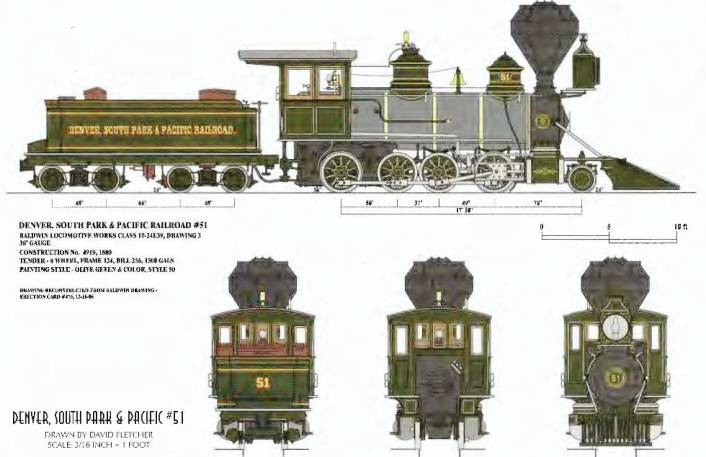
DSP&P #51 as built, drawn by David Fletcher, in
Sep/Oct 2015 NGSLG.
 The Aristocraft
"Delton Classic" 1:24 Scale Consolidations
The Aristocraft
"Delton Classic" 1:24 Scale Consolidations
In 1989, Delton Locomotive Works began producing
a Denver and Rio Grande C-16 Class 2-8-0, in 1:24 “H” scale,
matching all their other products. The good-looking body was
plastic with some metal fittings, and a good metal frame and
metal wheels. Unfortunately, the motor and gearbox were a little
primitive and it took 6 more years before all the mechanical
issues were resolved. It was painted in several variations for
the Colorado and Southern, among other road names, but none were
labeled for DSP&P at that time. A paint sample in garish red is
noted in Sloboda’s history of DLW, but it was never produced for
sale.
After a number of corporate shuffles, the tooling
for these locomotives ended up with Aristocraft Trains (now
out of business). In 1996,
they began marketing re-tooled versions of the Delton 2-8-0
under the Aristocraft “Delton Classics” trade name. Two versions
were painted for DSP&P: a wood burning DSP&P #63 with diamond
stack, and a coal burner, DSP&P #64 with straight stack and
modernized domes. These road numbers represent the Cooke-built
DSP&P locomotives #58 through #68, delivered to the DSP&P in
1883.
The level of detail is moderate compared to the
brass models discussed elsewhere on this website. The model
bears a strong resemblance to the builder’s photo of #63, but I
can’t vouch for accuracy of the dimensions. The finish is good
and equal to most moderately priced plastic models, Domes and
headlight on #63 are fancy, those on #64 more plain as befits a
more recent rebuilt locomotive. There is a wood or coal load as
appropriate in the tender. Cab doors and windows are immobile.
Couplers, on the rear only, are Delton knuckle type. My biggest
complaint about this model is that the engine number on the
boiler front is always "268", regardless of the actual road
number elsewhere on the model. It would not have cost much for
Aristocraft to do it right.
The original Delton Classic locomotive was not
“sound-ready” as this concept had not been developed at the
time. It is relatively easy to add basic LGB-style sound sensors
or full DCC and an American steam sound module in the tender.
Sadly, only aftermarket models of DSP&P versions
of the Delton Classic 2-8-0 are available today. Aristocraft had
commissioned David Fletcher to prepare a prototype for C&S #30,
and although it was a masterpiece, Aristocraft abandoned all
versions except D&RGW models of this locomotive. Aristocraft
ceased all production of model trains in Dec 2013, so nothing is
available except old stock in hobby shop inventory. The company
was resurrected as Polk's GenerationEXT (fall 2014) but no
rolling stock has appeared.
a Aristocraft
2-8-0 DSP&P #64
Aristocraft
2-8-0 DSP&P #64
Aristocraft 2-8-0 DSP&P
#63 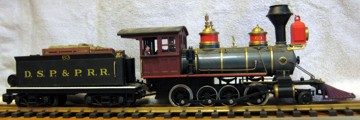
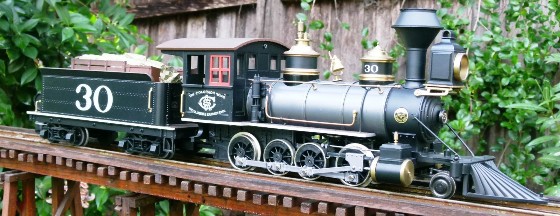
David
Fletcher's prototype model built in 2010 for Aristocraft, now
in my collection. The model features a lower profile than the older
production runs, more closely representing the real locomotive.
Aristocraft decided not to proceed with production.
 The Accucraft 1:20.3 Scale
DSP&P Consolidations
The Accucraft 1:20.3 Scale
DSP&P Consolidations
Accucraft’s DSP&P 2-8-0 Consolidation model locomotive, in
1:20.3 “F” scale, made its debut in advertisements in 2007 and
was delivered in 2010. The models were patterned after the
Baldwin Locomotive Works engine at the Colorado Railroad Museum.
This is the cosmetically restored DSP&P #191, previously #51
prior to the UP re-numbering in 1885.
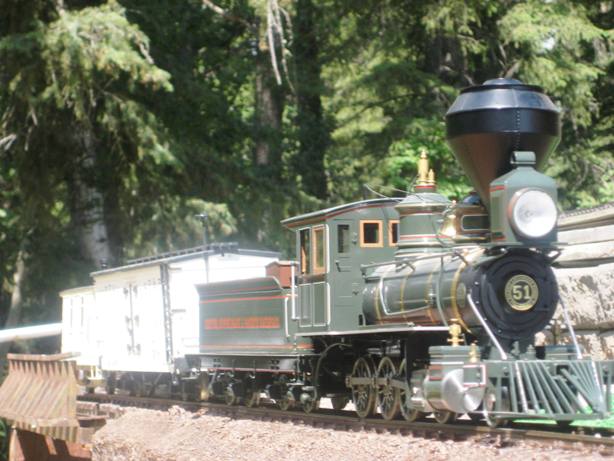 DSP&P #51 was one of eight such locomotives (numbers 50 through
57) acquired by the South Park. Consolidations were the mainstay
of Western narrow gauge railroads and some of these lasted well
into the C&S era. DSP&P #191 became DL&G #191 in 1889, then C&S
#31 in the merger of 1899.
DSP&P #51 was one of eight such locomotives (numbers 50 through
57) acquired by the South Park. Consolidations were the mainstay
of Western narrow gauge railroads and some of these lasted well
into the C&S era. DSP&P #191 became DL&G #191 in 1889, then C&S
#31 in the merger of 1899.
DSP&P #51 with a
Tiffany reefer and Waycar
#60 on the author's outdoor railway 
The models come in two liveries: a dark green version of DSP&P
#51 as it appeared in the 1880’s, and an all-black DSP&P #191 as
it appears now at CRM. Both have simulated Russia iron boilers.
Both were available as electric or live-steam versions. Plans
and liveries were drawn by David Fletcher – see more
HERE.
The body of the model is built from heavy brass with steel
drivers, side rods, and linkage. Level of detail is excellent,
especially the domes, headlight, pilot, and rivet patterns.
Paint and lettering is superb on #51 with all the ornate
curlicues expected in that era. Dressed as #191, the engine is
pretty “Plain Jane”, but that’s the way it really was. Domes and
headlight mounts on both models are just as elaborate as on the
Mason-built
2-6-6T’s. This locomotive carries the large Nesmith smoke stack.
The two center pairs of drivers are blind as they were on the
original.
The electric versions are sound-ready but not plug-and-play –
there is a rat’s nest of open ended wires in the tender,
accessed by lifting out the coal load. Coupler pockets are
designed for link-and-pin fittings (not supplied).
I
have no personal experience with the steam powered units. Online
reports suggest 30 to 40 minute run–times, depending on loading.
There are some good videos of these steamers on YouTube. The
engine has a single flue boiler, two cylinders with piston
valves, water level and pressure gauges, safety valve,
lubricator, simulated Stephenson valve gear, reverse lever, and
throttle.

Painting of DSP&P
#191
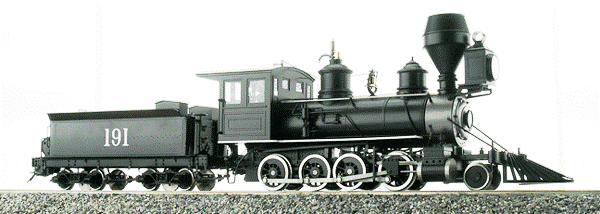
Accucraft's 1:20.3
scale model of DSP&P Consolidation #191 (originally #51)

Accucraft's 1:20.3
scale 2-8-0 painted for DSP&P #51 in 1885 colours, later renumbered
as 191.
 Accucraft's
DSP&P Freight Cars
Accucraft's
DSP&P Freight Cars
Accucraft's
1:20.3 scale waycar is pretty good.
Made of heavy brass with steel wheels, it comes
painted in straw yellow as a DSP&P un-numbered waycar or as a
brown, unlettered, generic transfer caboose. No dry transfer
numbers are provided by Accucraft to give the waycar a number –
that would have been a nice touch. I labeled mine as DSP&P #60
to match my 1:1
scale replica waycar / train storage shed.
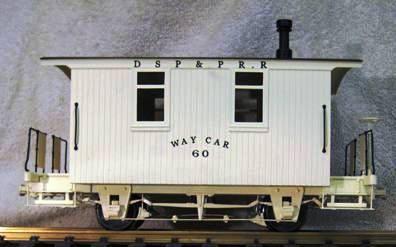
The Accucraft model generally follows the
dimensions of Charles Brommer’s plans for DSP&P #73 in the
Jan/Feb 1992 "Narrow Gauge and Short Line Gazette". However, the
window treatment on the model is weak – in the famous photo of
Waycar #72 (with Mason Bogie #42), the lower sash clearly slides
up inside the upper sash. The model does not replicate this
feature as obviously as it could have. The end railings include
a solid panel between each pair of inboard uprights, as on
Brommer’s plan. This ODD feature does not appear on other plans
in my collection. Brake rigging and pedestal details are good
but nothing moves. Doors
are spring
loaded
but there is no interior detail. Coupler pockets are designed
for link and pin fittings (not supplied).
 Hartford
Products DSP&P Freight Cars
Hartford
Products DSP&P Freight Cars
Accurate DSP&P freight
car models were produced by Hartford Products in 1:20.3 scale.
These were craftsman kits produced in the 1990's. Production may
have resumed after a long break in availability
-- see
Ozark Miniatures website
for availability. Here are the Hartford photos of their completed
kits. My only complaint about these models is their extreme
scarcity.

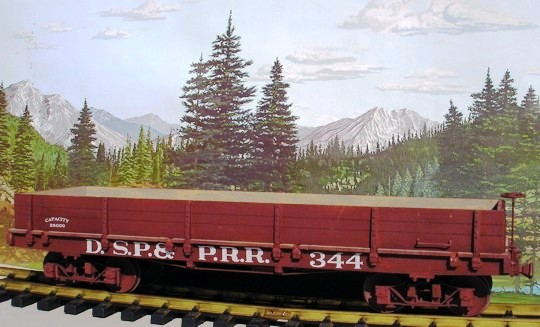
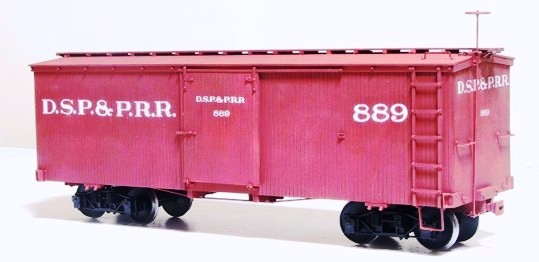

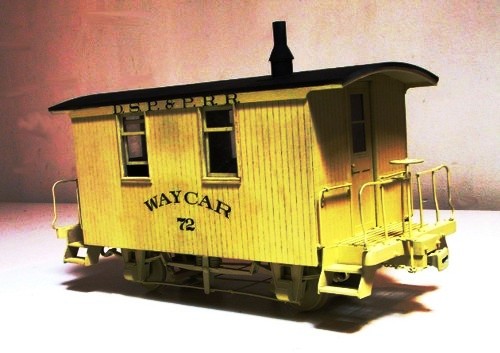
Above 5 photos: Hartford Products 1:20.3 scale DSP&P freight cars.
These are beautifully
designed and accurate craftsman kits.
 Delton
DSP&P Freight Cars
Delton
DSP&P Freight Cars
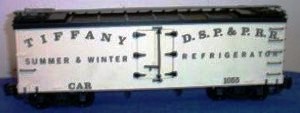
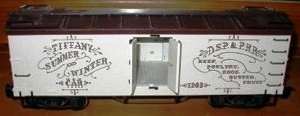
DSP&P Tiffany Reefers: Delton 1:24 scale "Plain" (available in 2
road numbers 1055 and 1056), and Delton "Fancy Script" version
(based on the Tiffany advertisement in the 1878 Car Builder's
Cyclopedia). Neither has correct roof or ventilation holes in
the end walls. The fancy script version never ran on the DSP&P.
About 1000 of each were produced in the late 1980's.
 Bachmann
DSP&P Freight Cars
Bachmann
DSP&P Freight Cars

The Bachmann 1:24 scale UP reefer has the correct road number
for the post-1885 era, but wrong roof.
 Aristocraft
"Delton Classics" DSP&P Freight Cars
Aristocraft
"Delton Classics" DSP&P Freight Cars
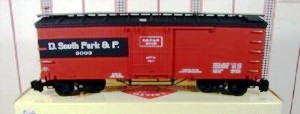


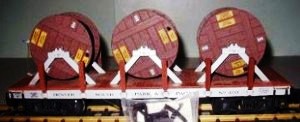

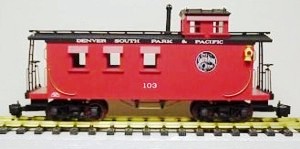
Delton Classics from
Aristocraft 1:24 scale. The Tiffany reefer has incorrect roof and no
ventilation holes, the box, flat, and gondola have the wrong road
numbers, the hopper is a Quincy and Torch Lake model and never ran
on the DSP&P, and the DSP&P never had a long caboose. And DSP&P cars
never had logos on their sides. Oh well, they are pretty!
 USA
Trains DSP&P Freight Cars
USA
Trains DSP&P Freight Cars
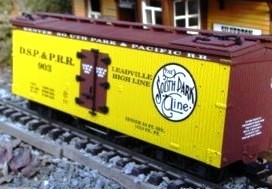
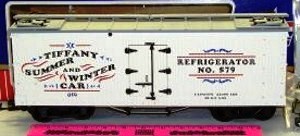
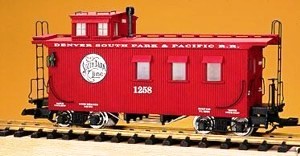
The USA Trains
1:24 scale reefer 903 has a logo and black paint on the doors that
shouldn't be there and of course the road number and roof are wrong.
They also produced a generic Tiffany car that had the ornate
lettering resembling the standard gauge car (not the DSP&P car).
They also produced a fictitious DSP&P long caboose.
 LGB
DSP&P Freight Cars
LGB
DSP&P Freight Cars
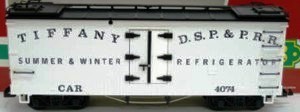
LGB's sole 1:22 scale DSP&P entry had wrong road
number, wrong roof, and no ventilator holes. Otherwise a credible
Tiffany reefer. Tens of thousands of LGB's Cooke 2-6-0 DSP&P Moguls
were produced -- why not a full train of freight cars? Marketing
people amaze me sometimes.
 Model
Die Casting DSP&P Freight Cars
Model
Die Casting DSP&P Freight Cars
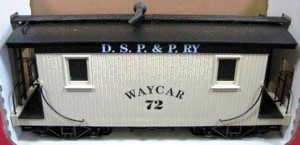
MDC turned out a
1:22+/- scale DSP&P waycar, but no other DSP&P cars. It has a
correct road number but the window arrangement is wrong and it comes
with two 4-wheel trucks instead of a 4-wheel bobber undercarriage.
 Customized
DSP&P Freight Cars
Customized
DSP&P Freight Cars
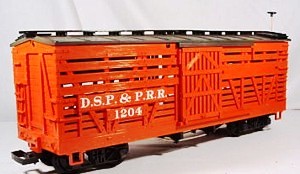

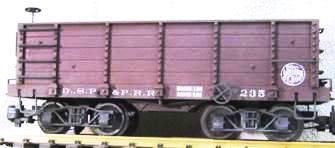
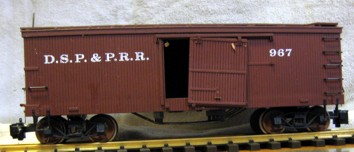
Some custom lettered
cars purchased from eBay vendors
 Dressing Up Commercial Large
Scale Rolling Stock
Dressing Up Commercial Large
Scale Rolling Stock
Commercial large scale rolling stock leaves a lot to be
desired if you want to be faithful to the idea of the DSP&P.
A few locomotives were manufactured that are reasonable
representations, but most other rolling stock is generic.
This page illustrates a few of the things that can be
done to commercial products to make them more like the
original and to make them unique to my railroad. To see what
DSP&P rolling stock should look like, see my DSP&P
Rolling Stock page, where
accurate models in various scales are portrayed.
The Rocky Mountain House, Leaverite and Northern Railway has
many interesting and unusual items on its roster. As the long
forgotten Canadian subsidiary of the Denver, South Park and
Pacific Railroad, most of the equipment is borrowed or leased
from the DSP&P.
Accurate large scale models of DSP&P locomotives and rolling
stock are rare and mine are no exception. Using commercial large
scale models, I have accepted some "as is", kitbashed others,
and relettered others to obtain variety and colour, giving
an impression of what it might have been like in the 1879 to
1889 era. Some were modified by other modelers and purchased
from eBay, then further adapted by me. Weathering varies from
slight to really grubby, depending on age and class of service.
The MOW cars are the most interesting, but the open loads and
reefers are pretty nice too.
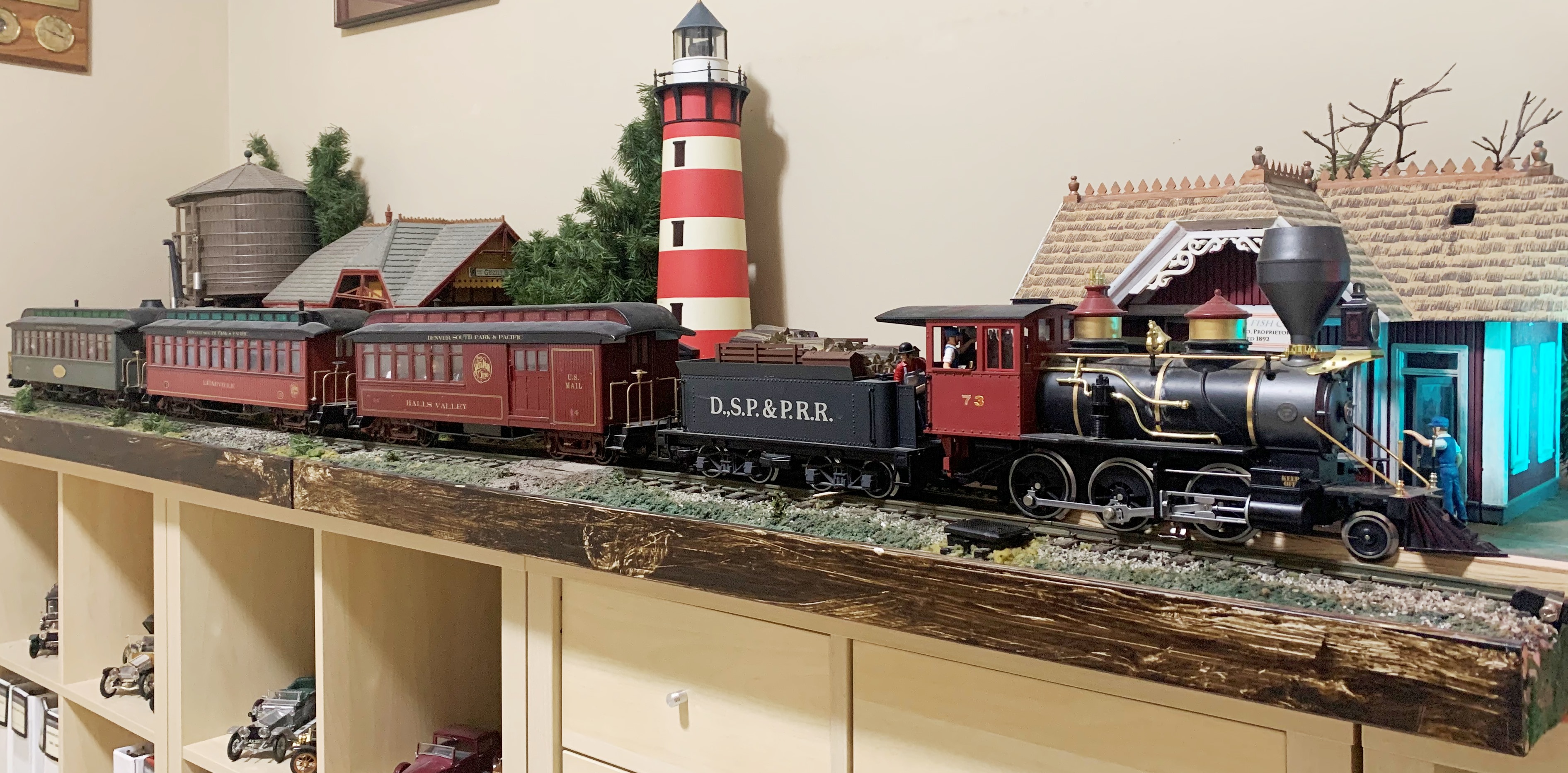
 Touch
Up The Details
Touch
Up The Details
Minor upgrades by painting
cast-in detail or modifying ladders also adds variety and
realism. Lengthening the brake staff is the most important
modification to make the cars look like they really belong on
narrow gauge track. My wife, Sonja, does the fine detail paint
jobs, sometimes with a single-hair brush. I do the rough
weathering and mechanical work.
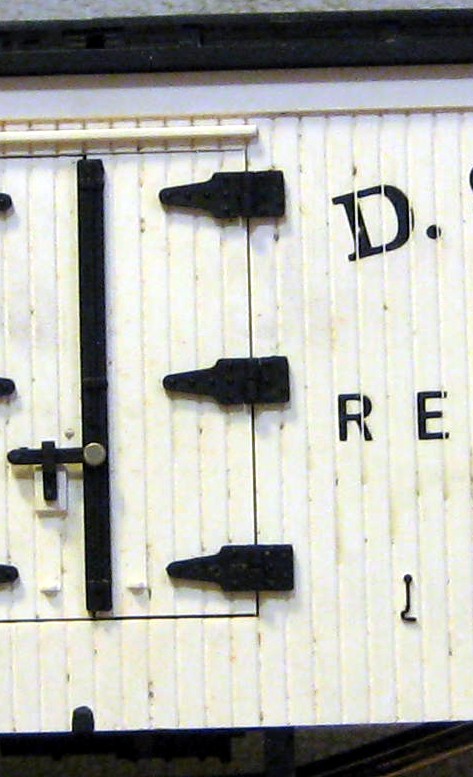

Cast in door
hooks on LGB reefer touched with black paint (lower right on
left-hand image). In the right-hand image, all hardware, brake
staff, and truss rods were painted black, with ice hatches
removed, air vent and ladders added, and a new road number
inscribed, making the LGB reefer closer to the 1880 prototype.
Steel wheels painted rusty brown look well used compared to the
black plastic originals. Knuckle couples (USA Trains are the
right size) painted grubby brown fix up the end view. I know
body mount link and pin would be more authentic and look better
but my curves won't permit this.
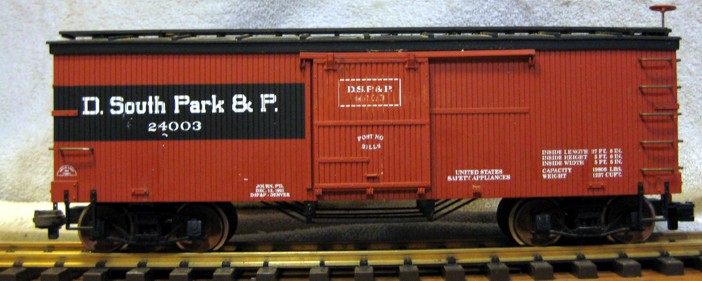
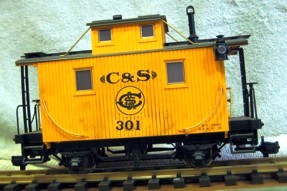
Just correcting the road number on a car can be satisfying. A
little research and some press-on dry transfers lead to more
accurate models.
 Back-date
A Commercial Car To Your Era
Back-date
A Commercial Car To Your Era
In my case, I wanted an 1880's
double-board roof on my house cars to replace the 1920's metal
roof on the original product..
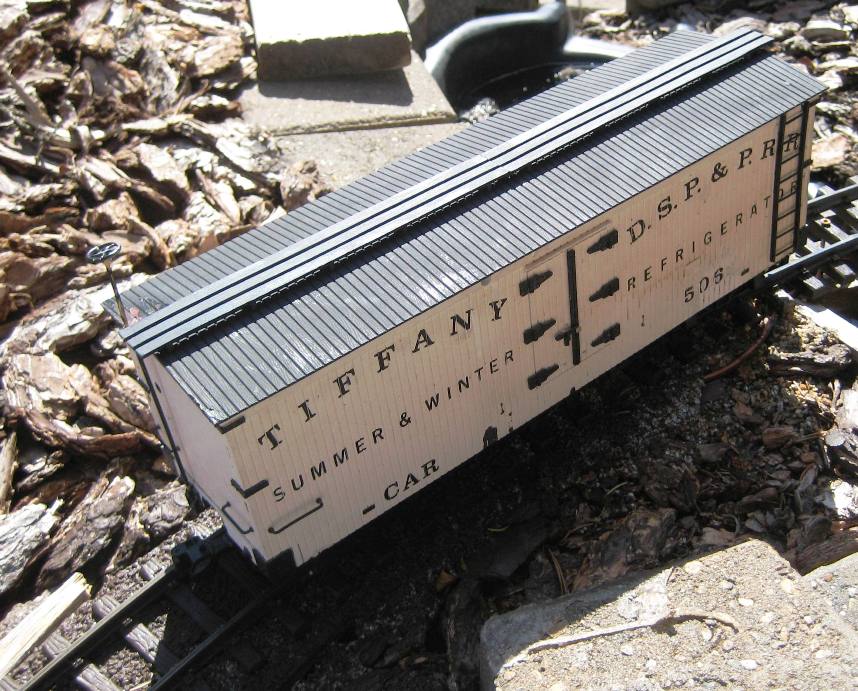
The Murphy patented "outside" metal roof didn't arrive until
1905 so no DSP&P car could have carried one until well along in
C&S service. Converting the poorly rendered Murphy metal roof on
the LGB, Delton, and USA Trains reefers and boxcars to a
simulated wood roof makes a huge difference. The cure is to
purchase some well used Bachman 933xx series boxcars at auction
and snap off the roof - it is simulated wood, and the only one
available in large scale. It needs to be shortened a bit in a
miter saw to replace the Delton and USA Trains roof, and
shortened even more for the LGB cars, then it just snaps into
place. Doesn't it look nice!.
 Add
Parts and Details for Unique Models
Add
Parts and Details for Unique Models
Many commercial models are
incomplete or have features that are not quite right for the
model's era or purpose. The examples below show some typical
situations.

The original USA Trains rotary was freelanced into DSP&P
Rotary O2. To improve visibility in blowing snow, a cupola has
been added. A roof and backhead were added at the rear using
Hartland parts, as were a bell and whistle on the roof. The
tender is from an LGB Mogul with sound added.
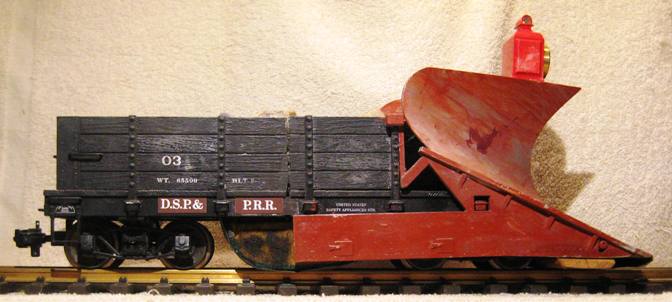
Wedge plow O3 sitting in the yard during a summer respite. This
is also my track cleaning car, with emery cloth under the plow
blade and a scrubbing pad under the body. It was kitbashed from
an Aristocraft plow, shortened by 3 inches, with a Hartland
headlamp added to backdate the original modern headlight.

Headshot of DSP&P wedge plow O3 showing rusting plow blade
before it gets scoured clean and shiny by the icy snow next
winter.
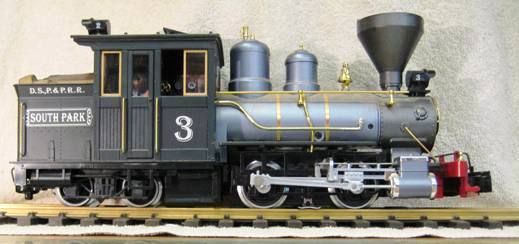

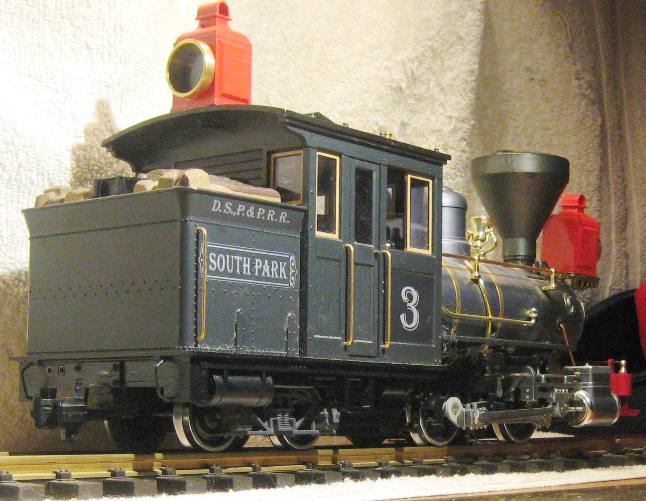
An old-timer with modern headlights just won't do. I added
Hartland headlights to help the
locomotive fit in better.
 More
Elaborate Kit-Bashes
More
Elaborate Kit-Bashes
Making completely unique
equipment or performing significant modifications to existing
commercial products is called kit-bashing. Lots of fun can be
had while doing the work, and observers will notice the special
effort.
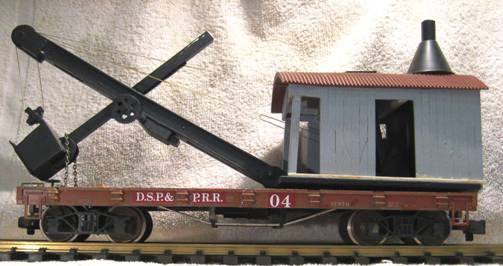
Steam Shovel O4 can be brought forward to clear the line of
avalanches and rock falls, or to widen a cut or clean up a ditch.
The enclosed cab is a real comfort to the crew in the minus 40
temperatures of the Northern winters. This is kitbashed from an
LGB flatcar and a JS Woodcrafts steam shovel with the track
assembly removed.
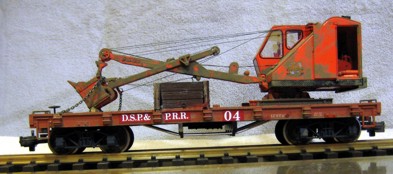
Add a diesel powered shovel for a more modern ditcher.
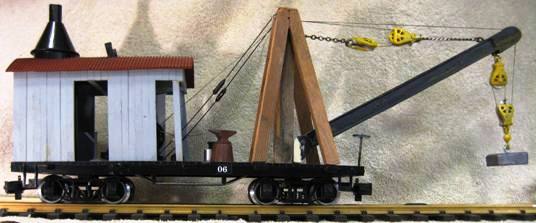
Starting with steam shovel parts and some Ozark
Miniatures pulley blocks,
a wrecking crane appears, loosely following a DSP&P
folio drawing.
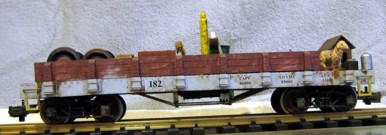
The wrecking crane tender/boom car includes lots of
tools, parts,
rope, chains, junk, and a guard goat.
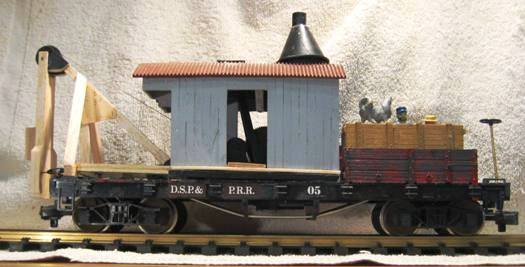
The pile driver uses the same steam hoist with a
free lanced mast holding
the pile driver's hammer.

Swap the
boiler for a locomotive with a different paint job, add a
snow plow and you have a unique engine on your roster.
 Open
Loads Provide Eye-Opening Interest
Open
Loads Provide Eye-Opening Interest
Whether on a flat car or in a
gondola or coal car, a load is a must. Few cars
run empty for very long.
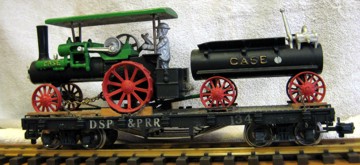
Machinery appropriate for the era makes a dull
flatcar into a detailed model.
All you need is some scale chain and a bit of
glue.
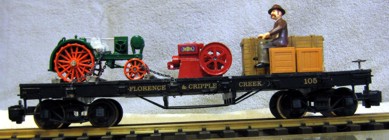
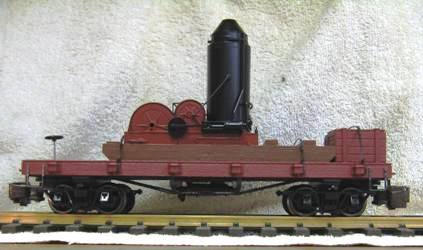
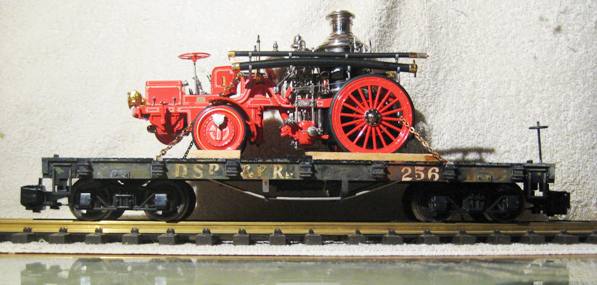
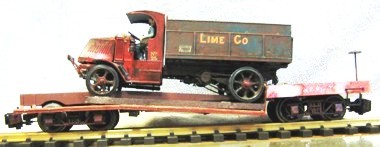
Four more of the open loads on my large scale
outdoor railway.
 Painting
and Lettering for Variety
Painting
and Lettering for Variety
Making it uniquely yours.

The right paint, people in the seats, and the car name plaque
give a realistic,
even if somewhat inaccurate, model.

If
you can see inside, there should be something inside to
see.
See: Photo
Galleries for Snow Fighting Traind and Work Trains for
more elaborate kit-bashing projects.
 Large
Scale Models of DSP&P Passenger Cars
Large
Scale Models of DSP&P Passenger Cars
This section describes DSP&P passenger cars available, with some
comments on the deficiencies. I have also shown some customized
cars that I managed to capture on eBay.

 THE
LGB DSP&P Passenger Cars
THE
LGB DSP&P Passenger Cars
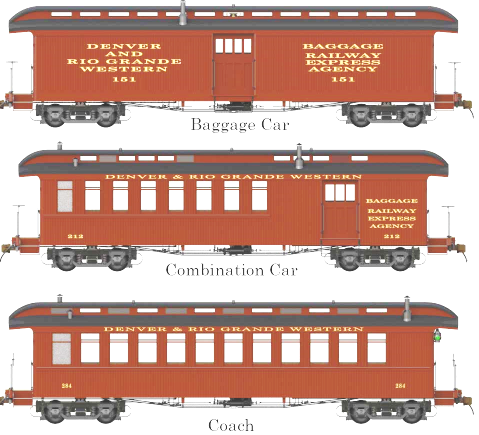 LGB
made the only ready-to-run Large Scale passenger cars labelled
for the DSP&P. They are patterned after the D&RG / D&RGW
Jackson and Sharp cars -- DSP&P never had any cars of this
type. The DSP&P models have a silver roof (should be black) and
need to be renumbered.
The cars are a little
short and shy of a few windows because of it.
LGB
made the only ready-to-run Large Scale passenger cars labelled
for the DSP&P. They are patterned after the D&RG / D&RGW
Jackson and Sharp cars -- DSP&P never had any cars of this
type. The DSP&P models have a silver roof (should be black) and
need to be renumbered.
The cars are a little
short and shy of a few windows because of it.
In the early years the DSP&P passenger cars were chocolate brown
or Tuscan red (mineral brown). The LGB cars are more like
caboose red, but are not too bad when not in direct sunlight.
At the right are Bill
Goulds renderings of the D&RG cars. Compare the window
arrangement to the LGB photos below. A few DSP&P cars are a
reasonable match to these models, notably the Bowers and Dure
coaches purchased second hand from the AT&SF.
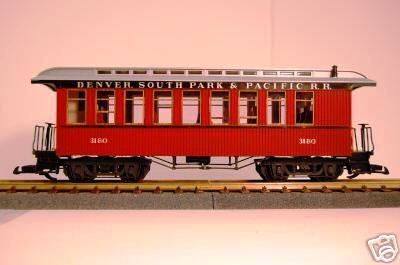
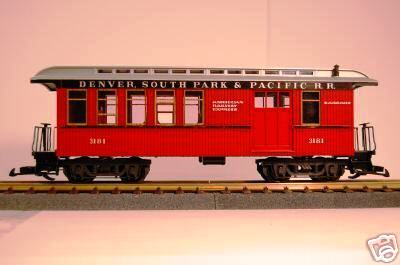
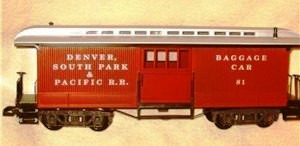
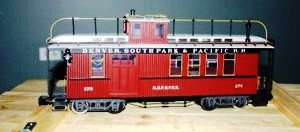
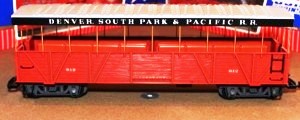
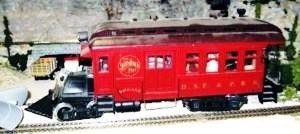
LGB's 1:22 scale DSP&P passenger cars need a little help - they
are all too short with incorrect window shapes and arrangements, but
black roofs and new car numbers will assist. There was no
combine-caboose or Mack Railbus (a Delton product) on DSP&P, but "it
could have been"! The correct colour should be more brown, but in
more natural light, the colour is about right (see below).

Here's what the LGB cars look like on my outdoor railway, after
painting the roofs black. The Delton Mason Bogie on the lower level
track looks more natural in daylight, too. It's the glare from the
sun on the black car roofs that makes them look silver, on models as
well as the originals in the old black and white photos, so don't
paint the roof silver - nature will do it for you.

The LGB model of the single door baggage car is a close match to
DSP&P #42. Note the new roof colour and the new road number.
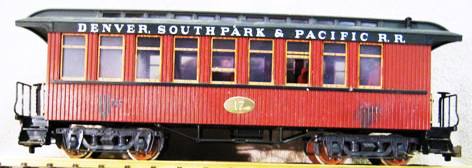
My LGB coaches have
been renumbered to represent DSP&P # 16, 17, and 24, built
originally by Bowers Dure for the AT&SD in 1879. The prototype had
13 narrow windows instead of the 10 wide spaces on the model.

My LGB combines have been renumbered to represent DSP&P # 23 and
25, built originally by Bowers Dure for the AT&SD in 1879.
These models are also a little short and need more and narrower
windows.
 Custom
DSP&P Passenger Cars
Custom
DSP&P Passenger Cars
Delton dressed a set of
passenger cars in DSP&P livery for advertising purposes but the set
was never produced for sale.

Depot G Hobbies offered a
Delton four car
DSP&P passenger train set with a 2-8-0 locomotive (DSP&P #65) in
1989-90. Unfortunately, none were produced for sale and this colour
sample was probably the only one to see the light of day. The garish
red loco and refrigerator car (#1070) may have played a role in low
interest, although the passenger cars looked like real winners. This
photo is from the Depot G advertisement in Garden Railways magazine.

The photos of the paint samples from Lenny Sloboda's book on DLW
history show a little better detail. Note the car numbers in the
round "blot" on the coach (#9) and combine (#6) -- both valid
pre-1885 numbers. The baggage-mail car is numbered 1301, a post-1885
number for car #43.
The Delton passenger
cars are now made by Hartland Locomotive Works. The long RPO,
combine, and coach in maroon can be relettered for DSP&P -- these
may be in short supply. Good decals were offered on eBay but
not seen recently. These cars are longer than the LGB passenger cars
so they look a little better.
The Bachmann Jackson
and Sharp cars are also decent models, and their maroon colour
matches the Hartland colour very well. Window arrangements are still
wrong for most DSP&P cars but they are a little longer than the LGB
versions, so they look pretty nice.
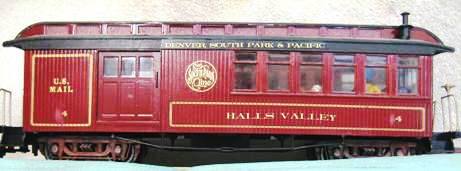


I purchased the above
3 cars from an eBay vendor. They are Bachmann kits painted and
lettered for DSP&P. The three photos represent 1878 Barney and Smith
combine #4 "Hall's Valley", coach #5 "Leadville", and Pullman-built
parlour car "South Park". As for the LGB cars, they are a bit short
and shy a few windows.

Some people have managed to improve the stock available. Bob Baxter
did a beautiful job of adding arch windows and reasonable lettering
to a Bachmann passenger car. Some very early photos suggest that the
roofs of passenger cars might have been painted with white lead, so
the white roof on this model is probably correct. Later photos
suggest sunshine on a black roof, which looks like light grey, not
white and definitely not silver or aluminum colour.
 Researching
the Wood Roof of the 1880 Era
Researching
the Wood Roof of the 1880 Era
This section covers my research on the wood roof used on freight
cars during the last part of the 1800s. All the large scale
models sold as 1880s era cars have simulated metal roofs because
that's what they have now at the Colorado Railway Museum. They
had wood roofs in the 1880s so I wanted to backdate the roof to
represent wood. A little work found out how the wood roof was
built and a quick scan of Garden Railway magazine found the
solution to the "Wood Roof Problem", as described earlier on
this page. Here's the gen on freight car roofs.
 The
Double-Board Roof
The
Double-Board Roof
John Maxwell's plans for some DSP&P house cars have the notation
"double-board roof" so it appears likely that most were built
with this kind of roof. Early cars may have had a single-board
roof at first. All of Ron Rudnick's drawings of DSP&P
house cars show "wood-board" roofs. The first Murphy metal
roofs didn't appear until 1906 and photos of C&S era cars show
no evidence that these or similar roofs were ever applied.
Below is the research that I could find on the Internet on the
subject of wooden roofs, followed by my solution to retrofit
wood roofs to large scale models.
 Some
Board-Roof Definitions
Some
Board-Roof Definitions
Four general styles of roof
construction were used in the 1880's on boxcars and refrigerator
cars:
1: the
double-board roof
2: the
single board roof covered with tin or other sheet metal
3: the
sheet metal roof protected by a single layer of roughly matched
boards
4: a
double roof consisting of an inside roof covered with felt, tar
paper or asphalted canvas and
an outside roof built over it to protect the roofing material
from injury.
Ridge pole -- runs the
length of the car along the centerline, under the roof, forming
support for the
peak of the roof.
Purlins or purlines -- beams that run the length of the car,
spaced between the ridge pole and the
exterior wall of the car to support roof boards.
Carlines or carlings -- beams that run from the car side wall to
the ridge beam, acting like rafters, to
support the purlins, which in turn support the roof boards.
Double board roof -- two layers of dressed 1x6 lumber, with
grooves to shed water, running from the
ridge pole to the car sides, painted before installation and
overlapped so that joints are offset from one
layer to the next.
Single board roof -- a single layer of boards as above but
covered externally by tarred canvas or
sheet metal, or with sheet metal underneath with or
without tar paper or tarred felt between.
NOTE: on a self-supporting
metal roof, such as the Murphy patent roof, the carlines are
outside the roof, not underneath, and act as both support for
the roof and as a water-tight seal at each panel joint. There
are no interior carlines or purlins, thus giving an unobstructed
interior to the car. Panels and carlines were galvanized to
resist corrosion. The panel joints and carlines were riveted,
and later welded, to form a "uni-body" roof.
 Research
Results - Double Board Roof
Research
Results - Double Board Roof
The double-board roof was the most common, well into the
1900's, but had disappeared on new construction in favour of all
metal roofs by the early to mid 1920's.
As quoted on the
Pacific NG website "In the
construction of this roof only the best seasoned white pine
boards should be used. A common practice is to use boards
dressed on both sides and edges to a uniform size of about 7/8 x
5 1/8 inches and have two semi-circular grooves of 5/8 inch
diameter on one side, near each edge. (running the length of the
board). The purpose of these grooves in the top course of boards
is to catch and carry off as much of the water as possible,
keeping it out of the joints; these same grooves in the under
course catch and carry off such of the water as penetrates the
joints of the top course. As the grooves in the under course are
apt to become clogged with dirt sometimes the two courses are
placed in contact so as to increase the size of the channel for
carrying off the water. The boards of both courses are nailed to
the plates, purlines, and ridge pole. The edges and faces
of the boards are always heavily coated with paint before they
are laid. The pitch of the roof varies from 1 ¼ to 2 inches rise
per foot. The steeper the pitch the better the protective
qualities of the roof but the more dangerous to trainmen who
have to pass over it."

Cross-section of the
two styles of double-board roof. It is not known which was used
on DSP&P cars. Only the version shown at the top of the image is
given in the Car Builder's Dictionary of 1879 and 1888. Note
that the grooves are not at the edge of the boards, as they are
on V-groove tongue-and-groove siding. I used Bachmann simulated
wood roofs to replace the Murphy style metal roofs on my large
scale DSP&P house cars, as shown later on this page.

Another drawing of the double board roof, an out-take from
Robert Stears drawing of D&RG reefer #119.
 Research
Results - Single Board Roof
Research
Results - Single Board Roof
The single-board roof became more common in the late 1880's and
early 1900's. It typically used wooden roof strips over each
joint in the boards and had metal inner roof to keep out the
water. There were many variations on the theme as car builders
progressed toward the self supporting metal roof.
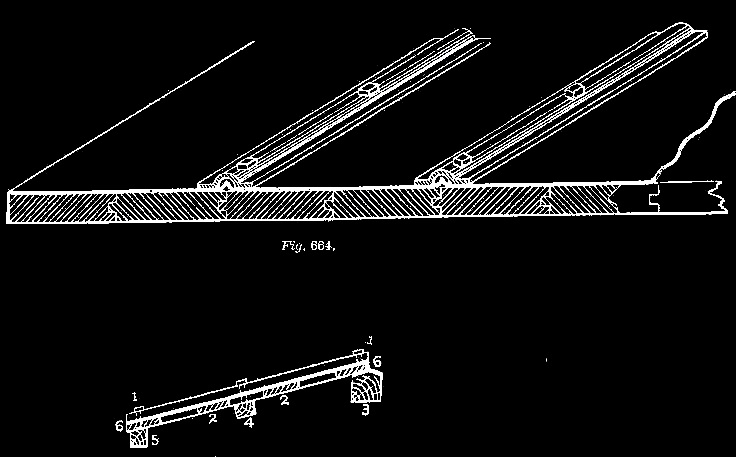
The single-board roof was made of T&G 1" x 6" boards without
V-groove edges. Some had metal above the boards, some had metal
below, some had roof-strips covering each joint. Cross-section
above from the 1887 Car Builder's Dictionary shows 1. roof
strip, 2 metal sheet underneath boards, 3. roof ridge pole, 4.
purline parallel to roof ridge, 5. car side-wall sill, 6. roof
boards. I have never seen anyone model roof strips and most
models show V-groove boards.
 Example
of the Double Board Roof
Example
of the Double Board Roof
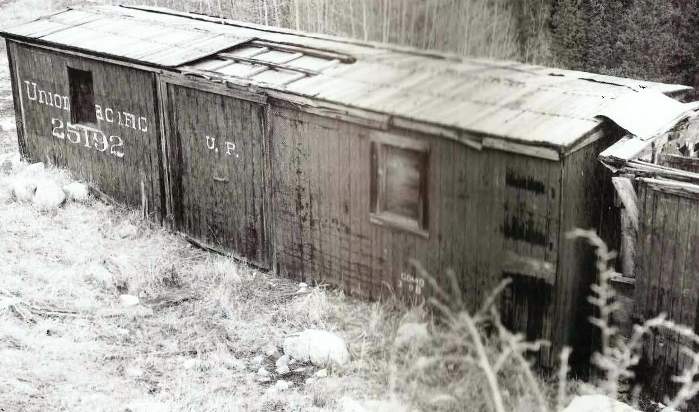
This is UPD&G boxcar 25192 on the ground near DSP&P tracks at St
Elmo near Aloine Tunnel in 1948 after more than 50 years of
weathering and modification as a shed. The sawed-out roof area
shows construction details including the near-side purline
running lengthwise halfway between the car wall and ridge pole.
Photo from "Narrie Gauge Pictorial" Vol VIII.
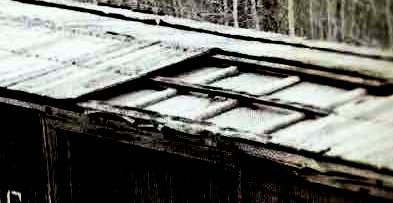
 Close up of the roof hints at the double board construction along
the lengthwise saw cut near the roof ridge. A carline is also
visible under the purlin, and the interior roofing below that.
Close up of the roof hints at the double board construction along
the lengthwise saw cut near the roof ridge. A carline is also
visible under the purlin, and the interior roofing below that.
 A Double Board Roof Solution for Large
Scale Models
A Double Board Roof Solution for Large
Scale Models

The Murphy patented "outside" metal roof didn't arrive until
1905 so no DSP&P car could have carried one until well along in
C&S service. Converting the poorly rendered Murphy roof on the
LGB, Delton, and USA Trains reefers and boxcars to a simulated
wood roof makes a huge difference. The cure is to purchase some
well used Bachman 933xx series boxcars at auction and snap off
the roof - it is simulated wood, and the only one available in
large scale. It needs to be shortened a bit in a miter saw to
replace the Delton and USA Trains roof, and shortened even more
for the LGB cars, then it just snaps into place. A little glue
makes it semi-permanent. LGB boxcars have the top door track
molded into the roof, so you will need to steal door tracks as
well as the roof, and glue them in place before installing the
roof.
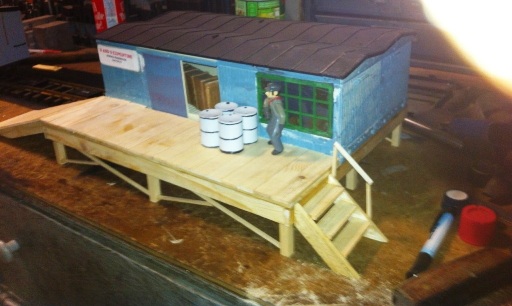
After you steal the roofs from the Bachmann boxcars, what do you
do with the leftovers? Remove the trucks, underframes, steps,
grab irons (both sides and ends), and the doors and door tracks
(one side only). Glue two cars side-to-side, add a platform,
stairs, freight, barrels, people, signage, and (of course) a new
roof. Here I used three of the LGB roofs to make the two needed
replacements. You could use simulated corrugated iron or shakes,
depending on your taste. The trucks, or at least the wheels,
from the Bachmann cars are probably better than some on your
older rolling stock, so use these spare parts to upgrade, or for
another kit bashing project.













 A
model of a 2-6-6T DSP&P Mason Bogie and a Waycar were advertised
in 1992 and 1993, manufactured by Midbar Locomotive Works.
Price, scale, and construction materials were not stated. A photo
caption in the Apr 1993 Outdoor Railroader indicates that the
locomotive was based on an inexpensive plastic superstructure,
probably the Echo toy train set, with a kitbashed Bachmann
caboose (images from OR Dec 1992 and Apr 1993). Based on
this scant description,
the
level of detail could not match that of the Delton and Accucraft
brass models described elsewhere on this page. The ads read
"Patience Please" for the next two years and disappeared by
1996, so this Bogie may have been vaporware.
A
model of a 2-6-6T DSP&P Mason Bogie and a Waycar were advertised
in 1992 and 1993, manufactured by Midbar Locomotive Works.
Price, scale, and construction materials were not stated. A photo
caption in the Apr 1993 Outdoor Railroader indicates that the
locomotive was based on an inexpensive plastic superstructure,
probably the Echo toy train set, with a kitbashed Bachmann
caboose (images from OR Dec 1992 and Apr 1993). Based on
this scant description,
the
level of detail could not match that of the Delton and Accucraft
brass models described elsewhere on this page. The ads read
"Patience Please" for the next two years and disappeared by
1996, so this Bogie may have been vaporware.




















































 Aristocraft
2-8-0 DSP&P #64
Aristocraft
2-8-0 DSP&P #64

































































